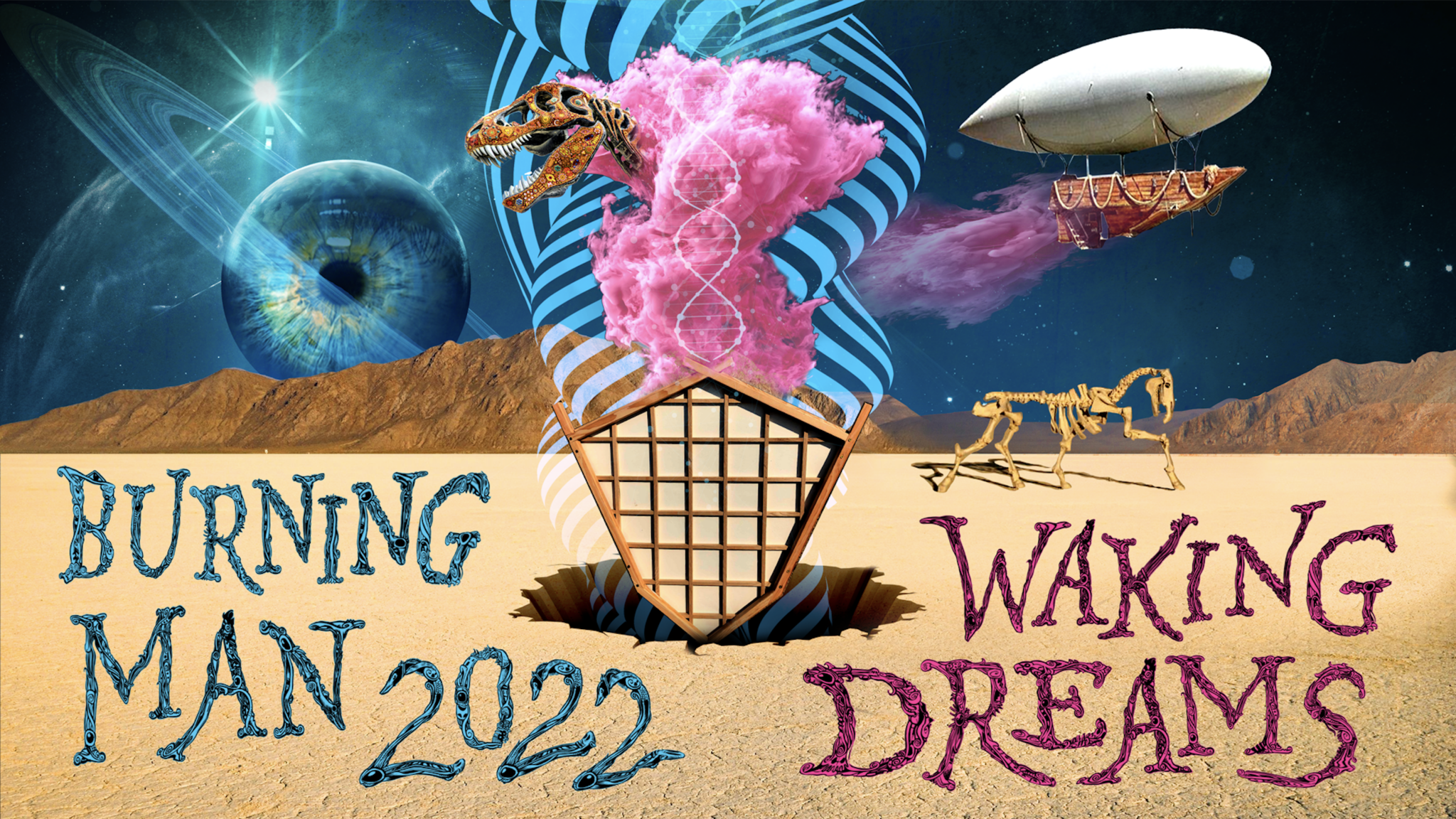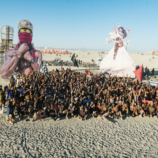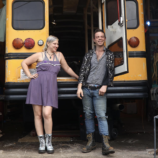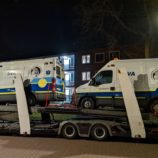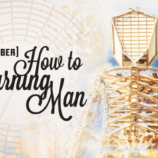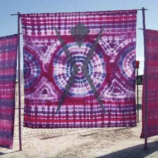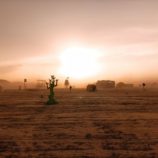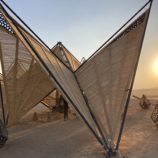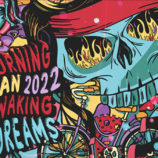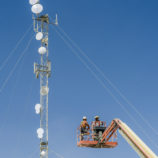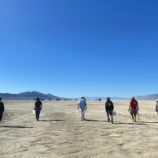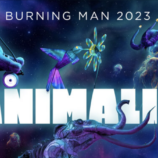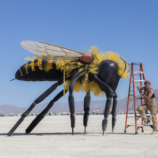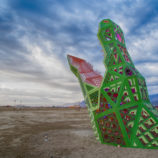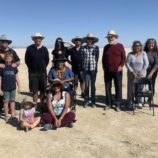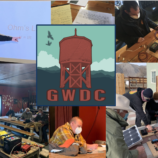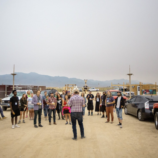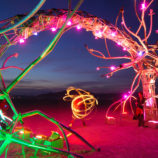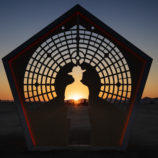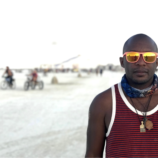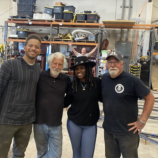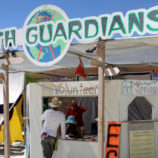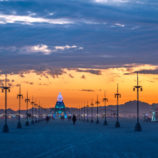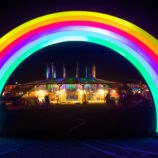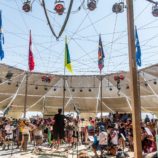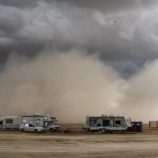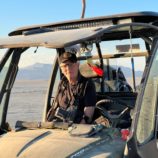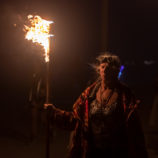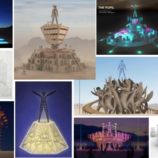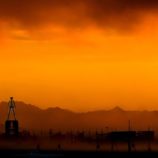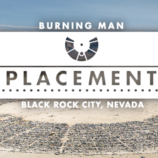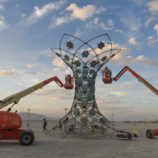The AfterBurn is our annual look back at the past year in Burning Man history — our ups, downs, and get-back-up-agains. Burning Man Project, the official name of the nonprofit Burning Man organization, is operated and supported by thousands of people who take responsibility for making Burning Man happen in the Black Rock Desert and around the world. The AfterBurn Report highlights what Burning Man Project’s various departments do, why we do it, what changes occur year to year, our successes and failures, and our vision for the future. Browse past years’ AfterBurns here. (We also annually publish the Dispatch, a richly-illustrated folio that tells the story of our year — as an event, an organization, and a global culture.)
Burning Man 2022: Waking Dreams
How We Built Waking Dreams
Every fall, once we’re all home and de-dusted, we ask all Burning Man Project departments and teams the same question: How was it for you? We then gather all the responses and publish them here as a learning tool, so event organizers and others outside Burning Man Project can learn from our experience and ever-evolving event cycle. The AfterBurn Report shares the story of our year-round operations from the hard-working teams who bring Black Rock City to life and support year-round Burning Man culture and community.
A Little Journey Back in Time
Recently we went back in time to peep past AfterBurns. Our very first Black Rock City AfterBurn Report was published in 2001; it’s short and sweet, covering the goings-on of just five departments (and an essay on the future).
Now Let’s Jump Ahead 21 Years
As Black Rock City and the Regional Network grew in magnitude and complexity, so did our year-round event cycle, operations and community work. Today, the AfterBurn Report spans more than 38 digital pages.
We have so much to share — learnings, unlearnings, relearnings (and forgettings). In 2022 Burners went from sheltering in place and tentatively organizing small events, to raising Black Rock City (and creating 73 in-person Regional Events) — with bells on.
Was it easy? No. Was it an astounding feat of logistical and cultural prowess? Yes. We’re proud of every human who brought their whole self to the mighty endeavor of building Black Rock City.
And Build the City We Did
Chris ‘ChAos’ Neary, Associate Director of Burning Man’s Department of Public Works (DPW) succinctly summed up 2022:
Adaptation is the name of the game when building BRC in an environment like the Black Rock Desert. This year really tested our ability to remain flexible and figure things out on the fly… We just put our heads together and got busy solving problems quickly as they arose. And the amazing members of our DPW crews stepped up over and over again to meet every challenge head on.
To all the teams that worked around the clock under difficult conditions to keep Black Rock City running — from Gate, Perimeter and Exodus (GP&E) to the Black Rock Rangers, DPW to Placement, and so many others.
Art, Diversity and Sustainability
And the playa came alive! More artists registered to bring their art to the Waking Dreams playa than ever before, including a record number of projects that represented diversity and emphasized sustainability. Black Rock City blossomed with 84 art installations supported by Honoraria grants, which include 48 from 2020 and 2021 as part of our Art No Matter What program. In total, Burning Man Project granted more than one million dollars to Honoraria artists and the Temple in 2022.
We leaned into our commitments to advancing Radical Inclusion, Diversity, and Equity (R.I.D.E.) and sustainability in our dusty home. Throughout 2021 and 2022 we cultivated new relationships and made it possible for first-time Burners to come to Black Rock City. Honoraria-funded art projects, camp communities and playa events expressed the diversity of the city’s population. Meanwhile, throughout Black Rock City there were noticeably fewer fuel generators, thanks to a proliferation of solar technology and expertise.
Thriving Year-round Communities
As part of their work supporting community resiliency projects around the world, Burners Without Borders (BWB) restarted their grant programs and hosted a productive Spring Summit at Fly Ranch. Around the world, Regional Events came back. Organizers showed up with innovative ideas that helped communities gather anew, and overcome fear and isolation from years apart. In Black Rock City, the Regionals team took to the dusty streets, encouraging participants to bring Burning Man into their lives year round.
Burning Man Hive thrived as a hub for Burners to build connections and learn from one another as they prepared for Waking Dreams. Now anyone in the global Burning Man community can follow the Core Curriculum in Hive, six courses with essential learnings for anyone wishing to level up in Burning Man culture.
It was a monumental year for our properties in Northern Nevada. Fly Ranch welcomed visitors to the land for campouts, nature walks, and Stewardship Days. Meanwhile, in Gerlach people came together to learn new job skills, work on community service projects, and envision a year-round center for Burning Man culture in Northern Nevada.
A Global Culture Connected by Storytellers
The Philosophical Center continued to share enlightening conversations on Burning Man LIVE, hitting 125,000 downloads by November 2022. The Communications team shared essential news and stories from the global Burning Man community via the Burning Man Journal. Every two weeks we reached more than 200,000 people via our newsletter, the Jackrabbit Speaks.
We Couldn’t Do Any of This Without You
People look to Black Rock City and global Burning Man culture as a beacon of hope for creative freedom and transformative possibilities. Without your imagination, your relentless energy and community spirit, Burning Man would not be the inspiring creative force in the world that it is today.
Table of Contents
For complete descriptions of the various Black Rock City teams, visit the Volunteer teams page.
1. Art & Civic Activation
Burning Man Arts
Katie Hazard writes:
Like the rest of the Burning Man Project organization, the Art department felt the more-than-usual challenge of bringing our event back to life after a few years off. The sheer effort of dusting things off, remembering how to Do All The Things, bringing several new staff members up to speed (without the benefit of on-playa experience), and — in some cases — compensating for loss of institutional knowledge in our department and others all felt monumental at times. But we did it! And we are proud of what we accomplished, including helping a record number of artists (420!) bring their artistic visions to Black Rock City 2022.
Among the artists of Black Rock City 2022 were 84 Honoraria grant recipients who fell into one of the following three cohorts:
- Artists who were originally selected as grantees in 2020, but who elected to bring their artworks to playa in 2022;
- 2020 grantees who were granted incremental funds in 2022;
- New 2022 grantees.
The first two cohorts posed a number of unexpected challenges for us, as they didn’t fit easily into our usual systems. Contracts, data records, grant management, artist communications — all had to be customized to fit the unique requirements of these groups. Thanks to the help of our amazing colleagues in Technology, Accounting, and Legal, we figured it out and pulled it off.
We’re particularly proud to report that the art on playa is mirroring our community better, in part because of our efforts to support BIPOC artists and women-led projects. In keeping with our organization-wide R.I.D.E. (Radical Inclusion, Diversity & Equity) initiative, we developed a curatorial strategy for our 2022 Honoraria program that resulted in increased diversity among grantees, including several first-time BIPOC-led projects.
We also increased our focus on funding and supporting sustainable art — projects that used recycled/upcycled materials, renewable energy sources, and/or promoted the theme of sustainability. Of particular note were our efforts to encourage the use of solar power by artists: 1) We partnered with Burning Man Project’s 360 team to provide solar power to 14 art projects, including the Temple; 2) We funded the Solar Library project, which supported six other artworks by providing a solar array to charge their batteries; and 3) We helped connect artists to the Renewables for Artists Team (RAT), which supported 25 art projects in converting to solar power.
- Despite the pandemic (or perhaps due to pent-up demand after several years off), we had more artists register to bring their art to playa in 2022 than ever before: a record 420 artworks. We are proud of how we successfully managed it, especially given the challenges of ramping up the event again. And we are so gratified by the gung-ho enthusiasm of the artists in our community, new and old, despite the many hardships they faced during COVID — projects canceled, art spaces closed, and health challenges, to name just a few. Although it is not an Art Department goal to increase the amount of art on playa year over year, the number of artworks continues to grow nonetheless. And we stay committed to supporting as many artists as we can who want to bring their interactive, community-built artistic visions to Black Rock City.
- During the past season, we encouraged and were heartened by many instances of our Burning Man art community supporting each other. Some examples:
- We helped connect first-time artists with their more experienced counterparts as mentors — such as long-time Burning Man artist Marco Cochrane, who took first-time BIPOC artist Erin Douglas under his wing and helped her and her crew navigate the complexities of building big art on playa.
- When Usha Seejarim faced extreme obstacles getting her visa in time to travel from South Africa to install her artwork “The Resurrection of the Clothes Peg” on playa, a host of Burners reached out to contacts in the diplomatic corps and managed to get the process “unstuck” just days before Usha was due to depart for the U.S.
- In celebration of Beckie Timovich’s final year as long-time Burning Man pyrotechnic maven, the Man Burn was particularly spectacular this year, with massive fire balls!
- The Art Department developed several exciting new communication tools to share our knowledge and departmental happenings. These included “Art Snacks,” regular weekly updates to the internal office staff, and “So You Want to Burn Your Art,” a new Fire Art course on our educational platform Burning Man Hive.
For the Art Department, 2022 was primarily a year of remembering and teaching/learning, rather than focusing on making big updates or changes to our processes. However there were a few ways in which we worked differently this past year:
- As with all of Burning Man Project, we had to determine new operating procedures for work on playa based on health and safety considerations for COVID
- We added a monthly Brown Bag Lunch series for artists pre-playa, giving them an opportunity to learn from staff, special guests, and each other
- For our Desert Arts Preview event, we helped organize a virtual reality (VR) element in which 52 artworks were represented
- We helped international artists address the extra challenges posed by COVID and various political situations
- We supported the Empyrean Temple crew and 55 other 2020 grantees through the three years between their selection as Honoraria and their on playa build in 2022
- We reconfigured the ARTery as its own structure on playa, separate from Everywhere
- FAST made improvements to their help desk system in the ARTery to help manage the workflow of fire artists
ART BY THE NUMBERS
- 420 art projects total (a record number!)
- 84 Honoraria art projects (up from ~70 in recent previous years)
- 48 carried forward from 2020/2021, with 36 new selections for 2022
- 42 international art projects
- 22 countries
- 17 US states
- 15 art projects that burned (13 plus the Man and the Temple)
- 24 art projects with flame effects
- 64 art projects with fire in camps
- 222 Art department volunteers
- 8 Quartermasters
- 62 ASS
- 19 ARTery ops
- 34 FAST
- 86 ARTerians
- 13 Eyes on Art
- 40 days on playa for Art department staff
LOOKING AHEAD TO 2023
Now that we have gotten through the heavy lift of bringing back the 2022 event in person, we have the capacity to turn our attention back to improvements in how we work. We intend to:
- Streamline and simplify processes, both within our department and in collaboration with other departments. This includes working on challenges that we identified during the 2022 season, both pre-playa and on playa.
- Create and implement a Good Standing program for artists, fostering a culture of mutual respect and equitable expectations in the support of the 10 Principles and a successful art program at Black Rock City.
- Review and compare the requirements, resources and benefits allocated to our six Art Department volunteer teams to achieve a reasonable balance between them.
- Further reconfigure the ARTery space to make it a welcoming space for artists, one where the community at large can learn about Burning Man Arts’ programs (and hopefully get inspired to create art themselves!).
We also intend to work on addressing challenges faced by artists in bringing art to Black Rock City:
- If possible, increase the number of transportation options available for artists, which were limited in 2022 due to BLM regulations about SRPs, making it difficult and very expensive for artists to transport their work to and from BRC.
- Recognize that the past few years have been exceptionally hard for artists, with rising costs and increased mental stress due to the pandemic; do what we can to support them in this area.
IN THE JOURNAL:
Burners Without Borders
Molly Rose writes:
This year saw the rebirth of the BWB grant programs!
Coming back from the pandemic, our communities asked themselves, “What is most important?” The answer seemed to be Burners putting down noncritical initiatives, re-centering on those that provided the most amount of value, and exploring new collaborations that leveraged the mighty power of community.
Community members attempted to rightsize, and discern the types of work that felt most resonant. As people came back post-pandemic, they didn’t have as much energy. So the things we as a community chose to engage in were the things that felt most important. People were re-assessing how and why they get involved with civic impact.
Part of our joy came from tracking this information through observation.
One of the ways Burners Without Borders tracked what is alive for the community is through the type of work that emerged through the return of our grant programs and convenings.
BWB Community Microgrant Program by the Numbers
- Number of applications: 106 (largest amount to date!)
- Global geographic spread: North American, South America, Asia, Africa and Europe
- Areas of focus: snapshot for applications and winners (graph)
Top-four Primary Subject Areas of 2022 (across all 106 grant applicants):
- Arts & Culture
- Education & Skill Development
- Environment & Sustainability
- Community Development
Top-five Primary Subject Areas (for 33 selected grantees):
- Environment & Sustainability (6 Grantees)
- Arts & Culture (4 Grantees)
- Education & Skill Development (4 Grantees)
- Community Development (3 Grantees)
- Food Access & Scarcity (3 Grantees)
Without analyzing the applicant data, our Grant Selection committee’s choices organically mirrored the patterns observed in the types of civic projects that were being submitted. We continue to receive information that — more than ever — our community is interested in supporting our natural environment and a sustainable future, alongside a creative future that centers on art and culture building. The vast majority of civic projects are interdisciplinary and intersectional in nature, which is why we request that projects select two subject areas to describe the nature of their initiatives.
In addition with BWB tracking the Community Response to Ukraine in 2022, we also hosted Community Roundup Calls. Here’s one attendee’s response:
“Thank you for all your support. I want you to let you know of your ripple effect: I attended the Community Roundup Calls during the pandemic, and I received so much value in launching my project from there. In the last two years we have delivered 300,000 meals (80kg) of food, and started an English class for 45 students in partnership with an actual school in Medellin! We also started a computer programming class for teens and female adults. We changed the name from ‘Feed the Barrios’ to ‘Empower the Barrios.’ And we now have 30 volunteers — all at a 97.6 percent donation-to-cause efficiency rate, with no admin costs… We believe that charity is not a zero sum game. We actually have re-donated 95% of all our money raised (with oversight) to other charities that do it better. The best example of this is we had a donor come to Medellin and wanted to donate a large amount for medical use. Yes, we could have used the money but our partner Emergencias Apolo (volunteer ambulance) was a better fit. The donor ended up donating an ambulance (worth $13,000 dollars)!” -Steve “Chabird” Cha (Square One Camp)
BWB also supported the development of two new volunteer teams on playa working towards the Sustainability Roadmap. Both of these teams came from the Green Theme Camp Summit that BWB produced in 2020. It had been several years since BWB instituted new Black Rock City infrastructure teams (previously Wood Recycling). So working with both Burner Leadership Achieving Sustainable Theme Camp (BLAST) and Renewables for Artists Team (RAT) were major successes and a big difference in our impact:
- BLAST had 21 camps sign up for the first trial run. Here’s the BLAST AfterBurn report.
- BWB supported RAT, whose volunteers helped 12 art projects get on solar for the first time. Here’s the RAT AfterBurn Report.
As mentioned, the BWB Microgrant Programs returned in 2022! Here’s our 2022 Community Microgrant Cycle.
The democratic consensus-driven granting workshop, Civic Ignition, returned at two locally organized leadership events in 2022. The Multi-Regional Summit selected four regional Grantees, and the Burners of New Zealand & Australia selected two Regional Grantees.
“I am so grateful for the support from Burners Without Borders. The Symposium was a fantastic day of connection as well as hearing from experts on cohousing from around Australia. The best news is the event has resulted in bringing together people interested in being a part of cohousing in Canberra. The videos of the presentations will be used in the years to come to help spread the word about cohousing around the country. Big thanks to BWB!” – Cris Clacus, Grant recipient from the Australia & New Zealand Leadership Summit Civic Ignition Grant
In 2022, we began to re-contract BWB Chapters into newly updated three-year agreements in 2022 — current status: 7 contracted Chapters; 6 Chapters pending/in good standing; 15 Active Working Groups.
BWB published Season Two of the Culturally Attuned podcast, launching episodes 9-17. This is the final completion of this project.
We tested running the Grant Cycle in the fall, rather than the spring. We hoped this shift would take the load off the return of BRC 2022; we were curious to know if this timeline works alongside our EOY responsibilities.
As a team, our BWB evolution included: Emma Weisman leaving her role as Associate Director of Operations, and the hiring of Jaymie Braun to backfill our Program Coordinator role (which had been empty since 2020).
BWB BY THE NUMBERS
- BWB Hosted participants at Fly Ranch for the BWB Spring Summit 2023, activating the Hualapai Flat for a sanctioned effigy burn for the first time since 1997— kicking off a new series of events.
- Engaged 130 BWB campers in producing the BWB Esplanade camp in Black Rock City, hosting various offerings for the public and amplifying civic impact of Burners around the world.
- Engaged with 24 projects through the BWB Project Proposal Form and new tracking process.
- 13 BWB Chapters contracted or in good standing/contracting in progress; 15 Active BWB Working Groups for a total of 28 activated groups across the globe.
- BWB supported two Civic Ignition Grant Workshops, and brought back the 12th Annual BWB Community Microgrant Program (after two years off due to the pandemic).
- Overall Granting Reach of 42 initiatives in 2022, distributing $45,000 in microgrants of $100-$1,500 per project.
- RAT worked with 12 artists to get on solar for the first time.
- BLAST worked with 21 camps for their initial run in BRC.
LOOKING AHEAD TO 2023
- We plan to implement more Standard Operating Procedures, per our organizational goals.
- We plan to more clearly articulate and define roles and feedback mechanisms internally.
- We plan to develop a 2023 schedule of activities starting in January.
LEARN MORE
- UK: The Times: Supporting Sofia Swire with Afghan refugee resettlement in Brazil
- The Future Of Canberra
- Culturally Attuned podcast, season 2
IN THE JOURNAL:
Community Events
Justin Katz writes:
In support of our top goal of bringing back BRC, we supported a series of virtual and in-person staff events called “Return to BRC 2022,” including the BRC Ops Summit in Reno, Nevada.
We continued to design, support, and scale up events in Northern Nevada — including campouts at Fly Ranch and new events in Gerlach and on The 360.
We took inventory of and mapped organizational meetings and events to support optimal timing and staff resource allocation.
As organizational goals naturally pivoted back to returning to Black Rock City, we took a hard look at the efforts made to respond to 2020 and 2021, including the development of Kindling and Virtual Burn. Those who worked on these initiatives were determined that our focus and support of these two community engagement endeavors could be re-imagined to better serve 2022 goals and community needs.
Our learnings from two years of supporting virtual and community events on the Kindling platform helped us improve our event visibility and functionality on BurningMan.org.
We were able to successfully integrate some of the virtual world platforms, such as BRCvr and Topia, into ongoing, year-round Burning Man Project events. A good example of this was an artist mixer in BRCvr that followed the virtual Desert Arts Preview event. This required extensive collaboration between the Art Department, BRCvr, the Tech Department, and our event teams.
In 2022, we expanded our team’s focus to support internal department events and new events in Northern Nevada.
Our team worked with Kim Cook, Rosalie Barnes and the Man Base team to support the “Happenings at The Man” community participation initiative in Black Rock City. While citizens explored and gathered at the Man Base, volunteers from the community gifted provocative pop-up happenings and participatory experiences, incorporating dance, performance art, original music and mesmerizing hybrids — often all at once! Individuals and troupes included Bad Unkl Sista, Daybreaker, Vau de Vire Society, Narcissister, Romain Collin, Yozmit, Ben Burke, Papa Bear and the Easy Love, Dan Bales, Capacitor, Sister Magic, Gamelan X, the Porn Klown Posse, Fou Fou Ha, Dr Lumington & Acaplaya Traveling Medicine Show, Sister Magic, BeLiewer and DreamWeavers with food offerings from Dustfish Pho and Turkish Breakfast Club.
VEST and BRCvr teamed up to hold a 2022 Virtual Burn on-playa Appreciation Party! After two-plus years of building cross-departmental collaboration supporting Virtual Burn events and experiences, we put down our virtual tool belts momentarily and raised a glass. World creators, builders, volunteers and participants gave each other in-person hugs and looked into each other’s eyes! It was truly a special moment to meet someone you’ve been working with for over two years in person for the first time. Trying to connect the actual human with those we’d only met as avatars or screen names was a fun party game. VEST Rangers from across the globe met in real life on the dusty playa to soak up the beautiful energy and scents — exchanging stories about that amazing virtual journey in The Great Unknown of 2021 and The 2020 Multiverse.
Justin Katz traveled to Antigua, Guatemala to speak about Burning Man culture and how we can co-create conditions for change in our communities.
Our focus on the Return to BRC meant putting our events in the Bay Area on hold, to be mindful of capacity and the unique challenges we faced after two years away from the desert.
Responding to a need to offer a consistent set of production values, methodologies, and standards, Executive Producer Justin Katz and Kindling / Virtual Burn veteran Chris Christiansen came together to create a Year-Round Events team to support departmental and programmatic presentations, gatherings and events with everything from calendar integration to event production. This year saw the team collaborate and produce over 30 different virtual and in-person events to support the nonprofit’s departments, programs, and initiatives. These 30+ events represented over 70 days of event production by our staff.
$teven Ra$pa prioritized supporting Regional Events around the world and the return of the Black Rock City Regional Event Lead Mentorship Program. He helped troubleshoot issues the community faced, including event insurance challenges throughout North America. On the communications side, Ra$pa helped kick off the “(Remember) How to Burning Man” series related to Black Rock City. He also provided input on projects to envision a more thriving Regional Network, reimagine Center Camp, and memorialize beloved members of our community.
COMMUNITY EVENTS BY THE NUMBERS
- Supported over 30 separate events produced by Burning Man Project’s departments and programs.
- Registered or sold tickets to 6,157 participants across our non-BRC events in 2022.
*See the Regional Network section of the 2022 AfterBurn (below) for interesting statistics related to the return of in person Regional Events and the Black Rock City Regional Event Lead Mentorship Program, which a member of our team managed.
LOOKING AHEAD TO 2023
- We’ve started the process of planning the 2023 year of events much earlier. We surveyed all 2022 event-producing departments and staff to create a draft calendar of 2023 events with increased visibility for all.
- We’ve introduced easier access to our processes, templates and production support.
- We are bringing together different stakeholders to talk about the return of larger convenings in 2024.
- We are revisiting how best to meet the needs of our San Francisco community after putting local events on hold. We are considering how the volunteer Community Events Team might continue to evolve.
LEARN MORE
- $teven Ra$pa’s Burning Man LIVE Podcast episode: “(Remember) How To Burn”
- Inventory of Burning Man Project’s 2022 Year-Round Events
- Justin Katz’s Volcano Summit presentation
- “Happenings at The Man” photos
IN THE JOURNAL:
Regional Network
Iris Yee writes:
2022 was a comeback year in the Regional Network. The joyous return of local communities connecting and galvanizing became apparent through the return of in-person Town Hall meetings, Burner meetups, and civic activities such as trash clean-ups in public parks. We witnessed a 70 percent return of official Regional Events that were held in 2019 — with caution, thoughtfulness and new ideas. In some cases, there was a release of pent-up creative energy which manifested as a strong year for art at events. In other cases, people were just happy to spend time sitting in theme camps catching up with friends. A proliferation of microburns reflected the need to reconnect in person without the risk and investments of creating larger events while COVID rates fluctuated. Boards and teams faced challenges but took steps to gear back up and rebuild teams and finances.
Regional Network Gatherings and Collaborations in Black Rock City
2022 was also a return year for the Regional Network in Black Rock City. As part of an initiative to rethink costs and operations, we learned that our previous home base in BRC, the Everywhere Pavilion, would not be built. Rather than staffing a fixed location, this created an opportunity to rethink where our team might have the greatest impact. We decided to take the message of the Regional Network to the streets of BRC instead!
The Regional Network Committee hosted Reflections of the Regional Network, a panel discussion held in Burners Without Borders Camp. It highlighted Germany’s Berlin Burner Embassy community space and new official Regional Event, Art Baer; and AfrikaBurn’s year-round land stewardship at Quaggafontein, R.I.D.E. efforts, and civic engagement in South Africa.
We collaborated with international Burners to host the annual Regional Network Celebration and Mixer for Regional Contacts and Regional Event Leads at Global Village, home to numerous international theme camps. We gifted handmade flags stenciled with “Ask Me How to Burn 365!” for them to fly in order to spark conversation about the Regional Network.
An expanded two-hour Exodus radio program broadcast on BMIR on Monday included eight organizers raising awareness of how Burners can bring their BRC experience home, and how to plug in to year-round Regional activities, reaching Burners in their camps, in their cars, and online beyond BRC.
Two evergreen radio announcements, co-created with Regional Contacts (RCs) about burning year-round, played on BMIR throughout the week and at Regional Events during the year through Shouting Fire.
The BRC Regional Event Lead Mentorship program returned with mentors from nine teams and 15 mentees from five countries, allowing for more focused support in this comeback year. Mentees were offered additional learning opportunities with 13 other teams in BRC.
The Regional Network Committee went to more Regional mixers and events hosted by Burners in camps and at art installations, strengthening relationships through beautiful real-life in-person technicolor!
We believe this strategy cumulatively reached more people than we might have in 2019 and encouraged them to bring the Burning Man experience home with them year-round. This decentralized experience of the Regional Network in Black Rock City reflected the decentralized nature of the many and varied communities within the greater Regional Network. We are everywhere!
The 2022 Regional Network Forum
At the 2022 virtual Regional Network Forum, Hello Again!, held on April 16, the Regional Network Committee welcomed Regional Contacts, official Regional Event producers, and community leaders across the global Burning Man community. It invited participants to venture out of private realities, experience the joy of reconnecting with peers, and reawaken inspiration in Burning Man culture beyond Black Rock City through discussions of how our local gatherings, spaces, and projects can be more inclusive, environmentally sustainable, and meaningfully connected. Forum content focused on addressing priority topics requested through 2021 Annual Regional Recap Reports and a survey of past Regional Network Forum participants. Program highlights included:
- Creative responses to community needs with Burners from Ukraine and the United States sharing Burner-driven Mutual Aid projects and the Temple of Tranquility
- A volunteer succession planning workshop led by Burning Man Project Founding Board Member, Harley K. Dubois
- Conversations about how Regional Events and communities are re-evaluating and changing their practices for environmental sustainability and a healthier planet with members from the Green Theme Camp Community, KiwiBurn in New Zealand, and MediMeisterschaften in Germany
- Facilitated discussion about evolving the Regional Network and what we might collectively want to improve upon for the next 25 years
- Discussion on how communities can develop culturally at a healthy pace with insights from an Israel RC Alumnus about a Burner personal development lifecycle theory
- An exploration of Radical Inclusion, Diversity, and Equity (R.I.D.E.) and how Burning Man groups across the world, including Black Rock City Rangers, are building an open, inviting, and inclusive culture through their team strategies and event operations
- A look at civic projects that bring a community together to create solutions with representatives of humanitarian Mutual Aid and Burners Without Borders projects
- Insight into community events and Regional Events-related challenges and solutions brought forth in a peer discussion lab with event organizers and the Regional Events Committee
Welcoming New Staff
After previous staff reductions, in July the Regional Network Committee welcomed a new full-time staff member who is focused on guiding Regional Contacts through their community service and leadership development lifecycle, from search to succession. An existing member of Burning Man Project staff also joined our team part-time to support Regional Events that are applying for official recognition. This restores our Regional Network Team to its prior 2019 staffing levels, and improves our capacity to support the Network.Graceful Transitions
The Regional Network Committee recognized the volunteer service of 18 Regional Contacts and celebrated their retirement, opening the opportunity for new leaders to step forward. George Paap, Burning Man Project’s first Regional Contact was among those recognized when he retired from his role after nearly 25 years as an RC in Austin, Texas. (Thanks, George!)Regional Contact Forums
The Regional Network Committee continued to produce two online Regional Contact Forums. Regional Contacts had the opportunity to learn about resources and discuss challenges related to volunteerism, and the emergence of Monkeypox. They also had the opportunity to share their 2022 successes and set goals together for themselves and their regions.Facilitating Peer Support
We continued to produce the “Trash Fence Café” Regional Contact peer-to-peer support calls, a virtual social hangout at the boundary between Black Rock City and the world beyond. The Café calls reunited Regional Contacts to discuss hot topics in their communities and share solutions. Meta Regional Contacts hosted a “Meet the Metas” session in January. Then in February, Regional Contacts shared concerns for the well-being of their fellow RCs and Regional Event organizers in Ukraine and Russia. This led to a discussion and support for various humanitarian aid projects for victims of the war.Supporting Local Leadership Events
The Regional Network Committee supported organizers at three local leadership conferences hosted to strengthen their Regional communities and develop best practices. Members participated and hosted or presented content at Emergence, a leadership event for the Pacific Northwest and Rocky Mountain regions; the Multi-Regional Summit, a leadership event for the Reno, Sacramento, Tahoe, and San Francisco Bay communities; and Burners of New Zealand and Australia Summit (BONZA). There was a locally organized Russian Burner Summit during which Burners discussed both the development and crisis in their community. They decided not to host their usual Regional Event and shifted efforts to support one another and humanitarian aid projects.Radical Inclusion, Diversity, & Equity (R.I.D.E.) in the network remained at the top of our minds. We created opportunities for RCs and community leaders to use tools to think about how to evaluate gatherings and spaces — using a “R.I.D.E. Stress Test” — by hosting two introductory workshops. Multi-Regional Summit sessions were produced with coaching from Regional Network Committee members and included discussion about the R.I.D.E. Stress Test. This tool also surfaced ways to address the challenges or participation in the BRC Regional Event Lead Mentorship program. We also invited discussion of R.I.D.E in action during the Regional Network Forum with examples from the BRC Rangers R.I.D.E. Delegation.
Environmental Sustainability in the Network
We created and amplified opportunities for RCs and community leaders to increase the environmental sustainability of their gatherings and spaces. This included a session at the April Regional Network Forum on how Regional Events and communities are re-evaluating and changing their practices for environmental sustainability and a healthier planet, featuring members from the Green Theme Camp Community (GTCC), KiwiBurn in New Zealand, and MediMeisterschaften in Germany. The session helped to bring an important discussion — led by GTCC and Burning Man Project Sustainability team members — to the Multi-Regional Summit.Evolution of the Regional Network
Over the last 25 years, the Regional Network has grown organically from three Regional Contacts in three regions to more than 200 Regional Contacts in 34 countries. Over 100 official Regional Events and thousands of community gatherings take place across the world in a typical year. In thinking about the next 25 years, the Regional Network Committee began a “25 to Thrive: Evolving the Regional Network” project to consider how the Regional Network can continue to evolve and examine how we might best foster and support the Regional Network into its next quarter century and beyond.Streamlining, Measuring and Sharing
At the end of 2022, the Regional Events Committee (REC) created and launched a new and simple digital form for Official Regional Event AfterBurn summaries. This will shorten the Annual Regional Recap Reports that Regional Contacts complete annually. It will also allow the REC to collect, aggregate, and share summary information about official Regional Events throughout the year as well as directly with lead producers.In-person vs. Online
The Regional Events Committee welcomed back 77 in-person and 4 online official Regional Events. The return of Regional Events brought challenges and opportunities.All events that were uniquely held online during the COVID-19 pause returned as in-person events in 2022; Burn2 in Second Life continued holding events in its online region as usual. In addition, BRCvr held unofficial online gatherings throughout the year.
COVID-19 Impacts
COVID-19 rates and mandates in some regions canceled early 2022 events, including Kiwiburn in New Zealand (January) and Blazing Swan in Australia (April).Impact of War
The war in Ukraine canceled burn events. Burners in the region turned toward different kinds of community-focused projects and gatherings, including Kurenivka Kids Camp, a summer camp for Ukrainian kids affected by the conflict, and numerous community-led Burners Without Borders projects. Russian Burners who gathered at Holodok added an impromptu vigil for peace. They later chose to cancel their summer event, Ogonek, out of respect for Ukrainian Burners and worked on local land improvement projects instead. Many in the community supported humanitarian aid projects and/or faced displacement and terrible violence of one kind or another. We continue to receive heartbreaking and inspiring stories about how Burners have applied the 10 Principles in service to their neighbors“Supporting and bringing value to society, daily, became a common practice… It’s hard to think about Burning Man right now for us, but I feel that our community will bring a lot of unique and valuable experience to the global community: How to become even more human in radical extreme situations.” – Volodymyr Nedogoda, Burner and co-founder of Magic Forest in Lviv, Ukraine
Regional Event Trends in 2022
- There was a strong appetite for Burners to reunite in person across the Network.
- Uncertainty associated with COVID rates, insurance, volunteer rates, and supply chain issues impacted decisions on whether to move forward with events.
- There was a rise in unofficial “microBurns” and backyard gatherings.
- 70 percent of Official Events returned, but many came back smaller to allow for an easier lift or to rebuild.
- There was a challenge to fill event leadership event roles and some teams experienced a loss of institutional knowledge when key volunteers did not return.
- Despite challenges, many reported their “best year ever” and found renewed meaning in their community gatherings and relationships.
REGIONALS BY THE NUMBERS
- The Regional Network is composed of 232 volunteer Regional Contacts in 114 regions in 34 countries and one virtual space.
- The Regional Network program is supported by 3 full-time and 3 part-time employees.
- 18 Regional Contacts retired from their RC role in 2022.
- No new Regional Contacts were added to the Regional Network. This was due to staff capacity and the hiring, onboarding, and training of a new staff member as we prepared to return to Black Rock City after a three-year hiatus.
- Official Regional Events nearly doubled from 40 (in 2021) to 77 (in 2022). We expect to see a further increase in the next 19 months toward the levels of 108 official Regional Events that were held in 2019.
- There were 73 in-person official Regional Events:
- 49 in the US, across 27 states — Arizona (3), California (4), Colorado (4), Connecticut, Florida (3), Idaho, Illinois, Iowa, Kansas (2), Maryland, Michigan, Missouri (3), Nevada (2), New Hampshire, New Mexico, New York (4), North Carolina, North Dakota, Ohio, Oregon (2), Pennsylvania (2), Tennessee, Texas, Utah, Vermont, Washington (3), West Virginia (2)
- 24 held outside the US, across 17 countries – Argentina, Australia, Austria, Canada (4), China, Denmark, France, Germany, Israel, Japan, Lithuania (2), Netherlands (2), Romania, Russia, South Africa, Spain, United Kingdom (3)
- There were 4 online official Regional Events — all were held in the long-established cyberspace region of Burn2 in Second Life.
- The smallest official Regional Event in 2022 was Melting Man held in North Dakota in February, with fewer than 20 people.
- The largest official Regional Event in 2022 was Midburn held in Israel in October, with 8,000 participants.
- New official Regional Events in 2022 were Reignition 2022: Remergence in Seattle (May), Melburn Wonderland in Australia (May), and ArtBaer in Germany (July).
- The 2022 BRC Regional Event Lead Mentorship program returned after a two-year hiatus, with mentors from 9 teams and 15 mentees from 5 countries. Mentees were offered additional learning opportunities with 13 other teams in BRC and access to year-round Burning Man Hive training courses.
- The Regional Network Forum succeeded in bringing together participants from around the world and was supported by a team of volunteers in collaboration with a small core production staff:
- 436 registered participants from 33 countries and 33 US states
- 18 speakers and breakout session facilitators from 6 countries
- 10 plenary and breakout session volunteers
- 6 core production staff
- Many of these discussions and presentations have become ongoing resources to help Regional Contact teams better plan and address challenges.
LOOKING AHEAD TO 2023
- We plan to expand the BRC Regional Event Lead Mentorship program to match more mentors and mentees and to release a toolkit so Regional Events can start their own mentorship programs to foster learning across Regional Events in the Network.
- We plan to continue to find new ways to introduce the people of Black Rock City to the Regional Network, moving through the city to meet people where they are. This includes potential activation in the Center Camp space at BRC, and partnering with a new camp or village co-host for the annual Regional Network Celebration.
- We intend to be more expeditious in helping leaders through the RC lifecycle.
- We intend to complete the examination, visioning and planning phases of the “25 to Thrive: Evolving the Regional Network” project, and thereby design a plan for a sustainable, inclusive, and thriving Regional Network for the next 25 years.
- We will explore what is required to bring back an in-person gathering of RCs, event leads, and other community leaders to share learnings and network in 2024. As many event leaders learned in 2022, to do so may mean doing so differently — perhaps on a smaller scale, in a more decentralized manner, in a way that does not overtax production teams and is financially sustainable.
LEARN MORE
- 2022 Regional Network Forum: Hello Again!
- Burning Man LIVE: Burning Man Is Not A Place (Featuring Iris Yee, Head of the Burning Man Regional Network discussing how Burners around the world activated during these strange times)
- Burning Man LIVE: Kay Morrison and the Overall Wonderment Quotient (featuring Meta RC and Burning Man Project board member, Kay Morrison)
- 2022 Official Regional Event List
- They Were Afraid of Being Drafted in Russia. ‘Israel’s Burning Man’ Provided an Escape
- This Long Beach Event Offers a Mini Burning Man Festival Experience
- Israel’s Burning Man festival to be held under noise regulations, organizers say
- Get Involved! Colorado’s ‘Temple of Tranquility’ Evokes the Serene Power of Burning Man Regional Temples — Past, Present, and Future by Denver RC, Rachel Cain
IN THE JOURNAL:
2. Burning Man Project Staff & Year-round Operations
Communications
Kirsten Weisenburger writes:
In so many ways, it was a groundbreaking year for Burning Man Project’s Communications team. Five out of the seven members of our team had started their roles after the 2019 event in Black Rock City. For these five, it was their first year working the event. Being new meant learning and onboarding to many engrained processes. It also gave us an opportunity to change things up based on new skill sets, team dynamics and capacity, and a desire to do things differently because we could. The Communications team gathered in Nevada in May 2022. We visited Burning Man Project’s Gerlach properties, the 360, Fly Ranch and the Work Ranch. This trip really helped us wrap our minds around Northern Nevada storytelling opportunities.
Preparing for a Return to Black Rock City
In the months leading up to the event in Black Rock City, each member of the Communications team played a key part in rolling out many updates, announcements, and operational plans.
Associate Director of Communications Dominique Debucquoy-Dodley and Black Rock City Communications Manager Leslie Moyer collaborated with Government Relations to update and finalize communications related to the Black Rock City Operations Plan.
Over the summer, Communications produced the Survival Guide, WhatWhereWhen Guide, and special BRC Editions of the Jackrabbit Speaks newsletter covering Art, Transportation, Kids & Families, Law Enforcement, Health & Safety, and Bikes.
Managing Editor Kristy Neufeld collaborated with every department in the organization to update every single webpage that required new and relevant information for Black Rock City 2022.
Content Manager Deets Shay developed oh-so-many social updates to get out critical information and acculturation content on social media. She also managed the participant sticker submission process, oversaw sticker selection, and launched Random Acts of Findness, a sticker scavenger hunt in Black Rock City. Random Acts of Findness formed just a part of our new opening section of the WhatWhereWhen, which pointed Black Rock City participants to fun and important things to discover in our dusty Home.
Communications Strategist Kirsten Weisenburger developed and wrote our 2022 Remember How to Burning Man acculturation series in the Journal and the Burning Man LIVE podcast. Writer and photographer John Curley continued his tradition of documenting the build of Black Rock City through several Journal posts.
Communications on the Ground in Black Rock City 2022
In Black Rock City, Burning Man Project’s Communications team and a group of amazing volunteers managed Media Mecca, the camp where journalists, videographers, photographers and drone pilots who document Black Rock City register their equipment and learn about the event. We also supported Black Rock City’s Radio Station BMIR, Census, and the Webcast.
On the ground, Communications managed emergency and crisis communications, interfaced with BMIR, and produced critical public-facing updates to go out on social media and BMIR.
During the event we collaborated with the Documentation team to gather photography and video footage of our remarkable dusty city and its inhabitants. Post event, we reached out to photographers and videographers to gather the best imagery from 2022 to be share on social media, our YouTube channel, and elsewhere. And we got to work tracking post-event media requests and published articles.
BMIR produced content related to R.I.D.E. and Sustainability, and collaborated with Communications and Gate, Perimeter and Exodus to disseminate traffic and weather updates as needed. They will release several of their on-playa R.I.D.E. shows via the Burning Man SoundCloud.
Census had a successful year of random sampling on playa. Their new Data Beast vehicle helped transport people around efficiently. The survey was open until October 20; Communications encouraged participation by sharing the Census on all channels.
The Webcast delivered great programming this year, and had several team members step into leadership roles.
New Staff, Fresh Storytelling, and New Collaborations
Early in 2022 we hired Carly Rhodes as our new Communications Administrative Coordinator.
It’s been a busy year on social media for us, bringing everything from education, nostalgia, humor, video, and even a bit of snark to our feeds. We’ve promoted more Mutant Vehicles, more Theme Camps, and more art on playa than ever before via new Facebook albums, Instagram carousels, and Instagram Stories. It’s been a blast introducing several new content series into the mix: we’ve been exploring the principle of Immediacy via our content series “Night & Day,” which juxtaposes photos that capture evanescent moments of a single subject.
Leading into BRC 2022, we created social media content to educate participants with nostalgic Tip Sheet throwbacks, helpful reminders, and some ever-so-snarky limericks. Additionally, we engaged our followers with open-ended questions that started conversation and offered a space to help out their fellow Burners. It’s been exciting to see engagement go up, sentiment turn positive, and our followers increase as we head into another year.
Members of the Technology and Communications teams formed an Information Architecture Working Group to help rethink and revamp our main BurningMan.org website. The goal: make the website easier to navigate and its contents more digestible for visitors. By the end of 2022, the Working Group had shuffled website content, updated images and page themes, adjusted nomenclature and optimized organization throughout the site, restructured navigation for both main landing pages and subpages, and overhauled the homepage layout, header and footer for a vastly improved user experience overall. These efforts were merely the beginning of a larger ongoing project. As we head into 2023, our teams plan to continue to improve the navigation, content, and experience for visitors of BurningMan.org in myriad ways.
The Communications team collaborated with Philanthropic Engagement to release the 2021 edition of The Dispatch, our annual look back at some of the powerful stories, events and learnings in the global Burning Man community during the previous year.
Erin Douglas, founder of the Black Burner Project, wrote Journal pieces about diversity in the Burning Man community.
The Speakers’ Bureau supports Burning Man staff, founders, and community members who are presenting at events and conferences around the globe. After a couple years spent collaborating with mostly virtual events, it was exciting to once again share our perspective and participate at some significant in-person conferences.
- In February, Stuart Mangrum presented at the State of Downtown event in the City of Sacramento (produced by the Downtown Sacramento Partnership)
- In June, Harley K. Dubois was the keynote speaker at the Experience Summit 2022 in Sydney, Australia
- Also in June, Erica Blair represented Burning Man at The Klosters Forum in Switzerland
- In July, Harley K. Dubois spoke at the Festival of Consciousness in Barcelona
- In November, Harley K. Dubois facilitated an interactive experience at the Global Citizens Forum in RAK, UAE
Communications collaborated with the Sustainability team to draft an overview Journal post and publish a fresh web page highlighting Burning Man Project’s sustainability work and Year Two Sustainability Roadmap update. And we supported Ticketing to publish updated information about Black Rock City 2022 ticket sales.
Communications created and reviewed social media content, a press pack, and press release for the opening of Radical Horizons: The Art of Burning Man at Chatsworth, where several large-scale works by Burning Man artists were installed at a country estate in the UK.
Syncing with our friends over at the Philosophical Center, we helped to develop stories and get the word out about the Burning Man LIVE podcast. Working with Burning Man Publishing, we developed a communications plan for Caveat Magister’s new book, Turn Your Life Into Art: Lessons in Psychomagic from the San Francisco Underground. We’re excited to be planning communications for the winter 2022 release of the next Burning Man Publishing Title, Once Upon a Time in the Dust: Burning Man Around the World by Roxane Jessi.
Heading into the 2023 event, Communications collaborated with Stuart Mangrum on the 2023 BRC Art Theme, Animalia, and supported Katie Hazard to publish Black Rock City Art updates, announcing 2022 Honoraria recipients, and kicking off the 2023 Honoraria and Temple grant cycles so we can do it all over again.
Communications led a revamp of the 2022 WhatWhereWhen guide, which included the creation of a new illustrated front section, the “Insiders’ Guide.” These special pages in the front of the book highlighted Burning Man Project initiatives and fun community offerings. We also rolled out new WhatWhereWhen categories in the 2022 book.
After visiting Burning Man Project properties in and around Gerlach to gain a better understanding of the strategy for development, the Communications team collaborated with Nevada Operations on strategy and a Journal post to get the word out about these projects. We’re currently working with a Reno-based videographer to create a video about the various projects in Northern Nevada.
Co-creating the first Burning Man event in Black Rock City since the COVID-19 pandemic required strategic management of community safety content. Communications led updates to the “Community Care” COVID-19 safety page on the Burning Man website. We collaborated with Media Mecca, BMIR, and Census on our teams’ COVID-19 safety plans, and worked with Government Affairs, People Operations and others to dial in COVID-19 and Monkeypox pre-event messaging.
COMMUNICATIONS BY THE NUMBERS
- Jackrabbit Speaks (JRS) metrics hit an all-time high: we averaged a 43 percent open rate and 2.7 percent click rate for 2022
- We sent 27 JRS editions, hitting a peak of 250,205 subscribers
- Burning Man Journal: 81 posts published; 20,840 subscribers
- Facebook: 1.3M followers
- Instagram: 1.3M followers
- YouTube: 53.3K subscribers
- Medium — Beyond Burning Man: 820 followers
- We have received (42) speaker requests: (18) for in-person speaking engagements, (13) for interviews, (11) for virtual events. We’ve participated in 23; we have accepted and not yet completed 5; 3 are under review; 7 have been declined.
LOOKING AHEAD TO 2023
Who we are now as an organization and what has changed?As we step into a different moment in 2023, our team plans to refresh and reevaluate our channels, reorganize projects to align with who our audiences are and what they need throughout the event cycle.
We are redefining and planning our cultural content and storytelling with an emphasis on diversity, sustainability and Burning Man history. We’re exploring new channels and mediums, and listening closely to the needs of the global Burning Man community to determine how we can best support the next evolution of Black Rock City and the global culture.
As we look to the 2023 event in the desert, our team will be streamlining our Black Rock City operations and processes to more efficiently utilize staff and resources.
LEARN MORE
- The San Francisco Standard: Burning Man CEO Explores Its ‘Absolutely San Francisco’ Culture Ahead of First Gathering Since 2019
- The Guardian: Burning Man blazes into Britain: Can its wild sculptural magic work in the dales?
- National Geographic: Burning Man shows how a riotous festival can be accessible
IN THE JOURNAL:
Documentation Team
Michael “Dustin” Fasman writes:
In 2022, an unprecedented 98 percent of our Doc team returned from 2019, including two cancer survivors and five newbies, one of which had never attended the event — a first for our team.
- We worked closer with the Communications team, including providing photos during the event for social media.
- We shot videos for Philanthropic Engagement and the Legal department, more firsts.
- We had the first Regional Doc team (NY Decompression).
- We followed COVID-19 protocols, which we noticed often hampered collaboration.
- The frequent, intense dust storms posed challenges to photographing the event and gathering with teammates.
DOC TEAM BY THE NUMBERS
- 5 new volunteers (1 of whom had never before been to BRC!)
- 48 out of 50 past volunteers were eager to return
- Approximately 2,500 – 4,000 photos were uploaded and tagged into Widen, our digital asset library
- Our team included 8 international volunteers from Central America, Europe, and Australia
LOOKING AHEAD TO 2023
- We need to improve our assignment planning and distribution process to team members.
- We will institute optional but recommended daily drop-ins by volunteers to check our assignment and message boards.
- We plan to create a program where photographers share a few of their best photos every few days, enabling us to share them with the Burning Man Project Communications team for social media and the JRS.
- We will expand the Doc team to more Regional Events.
- We will be requesting a shade structure next to our OC.
LEARN MORE
Education
Karen Jacobs (aka KJ) writes:
The theme of 2022 for the Education team was Connection and Expansion. We saw continued growth of Burning Man Hive, an online community and learning network helmed by the Education team. We deepened existing collaborations, opened up new partnerships, and added new faces to the team.
If the top story for Burners this year was getting back to Black Rock City after the wild and intense years of the beginning of the COVID-19 pandemic, then our team was very much immersed in that story, as individuals, as staff members, as Burners, and as the administrators of Hive. It was challenging, rewarding, and humbling.
The ability to utilize online connections for our community was incredibly meaningful and powerful. The collective trauma the world experienced for the last few years — politically, socially, physically, mentally, emotionally — has touched every human and every Burner on the planet. With Hive, we were able to continue offering points of connection, learning, and action in the realms of R.I.D.E., Sustainability, Wellness, and last but not least, Black Rock City preparation. It was thrilling and terrifying on many levels to contemplate a return to our dusty metropolis; as a community, we leaned into each other, and Hive was able to play a big part in this.
Internally, we saw new collaborations emerge with teams including Art, DPW, ESD, and the Airport — creating courses for their specific sub-teams and communities, and expanding ways in which their teams could connect online. We were also able to use Hive as a resource library for staff: archiving meeting videos and making available, for the first time, courses and discussions that have previously only been available to staff who could attend in-person gatherings in the Bay Area. We are excited to keep growing in this direction and feel that Hive’s potential as a resource library for Burner culture is just beginning to be tapped.
The Education team was able to launch several new courses, discussion topics, and groups to support logistical playa preparation, as well as the mental and emotional wellbeing of our community (whether going to BRC or not). This work, especially course development, represents a huge lift in research, trial and error, and work hours. It was a huge learning experience for our team members and one we can pay forward into the rest of Burning Man Project and the global Burner community.
And let’s talk about the community. It is an incredible privilege to facilitate a network by and for Burners. It was humbling to see what the community was passionate about and wanted to bring forth, for each other: learning opportunities around Sustainability, ways to give back to our indigenous neighbors in Northern Nevada, connection points for Burners of Color, content for new Burners coming to BRC for the first time. It was exciting to be able to give these voices a place to sing out to each other. While our team continues to ride a sharp growth edge in learning the best ways to support, and also knowing when to step in and when to get out of the way, we also know that this is where the work is happening: the work of facilitating learning between members of our community, and not just sharing learning from Burning Man Project towards the community.
This growth edge, this team expansion, will carry us into 2023. We had some turnover in 2022, with our first Volunteer Coordinator (VC) resigning and our new replacement VC not signing on for several months. It will take us some time to revamp our volunteer team, and figure out how to best engage them in a year-round capacity that inspires ongoing contribution without burnout. We are figuring out how we can best collaborate with one of Burning Man Project’s cultural founders who wants to make learning and community support a part of their legacy. We have a new team member, and we are excited to see what we can accomplish with our small and mighty team growing by one! With the first event cycle since the start of Hive behind us, we are more excited than ever to look ahead to BRC in 2023 and see what awaits our team and the worldwide Burner community.
- We made Hive more accessible via the creation of our course “This is How We Hive”, giving users a resource guide on how to maximize usage of the network.
- We launched a Core Curriculum — these six courses represent core learnings that have previously only been available to staff members at attendance at in-person meetings or retreats; now all members of the worldwide Burner community can access these Core Curriculum courses at their convenience:
- Through groups such as the Burners of Color Resource Group and the Multicultural POC Neighborhood Group, Hive was able to support Burning Man Project’s efforts to distribute tickets to more Burners of Color.
- To support the worldwide Burner community in the return to Black Rock City, the Education team created informational content about being on playa, while also supporting members of the community in creating their own content. Courses, groups, and topics included:
- We heard from individual Burners who found community, information, and knowledge in Hive that helped them plan their first trip to BRC. People were inspired to get involved, create the groups and connections they wanted, and even start their own camps!
Education Staffing Changes in 2022
- 2022 was the first year our team was together in BRC, with some team members working their first season and/or attending their first event. We spent much of the summer focusing on building rapport among members of our distributed team and working on acculturation to working and thriving in BRC.
- Harley K. Dubois, Cultural Founder, declared her goal of working more closely with the Education team to produce learning content based on her years of volunteer leadership, community building, and process development in BRC.
- Our team added a third member: Viviana Duplan joined Burning Man Project in June to support both Education and Harley.
- Heidi Pickman (aka Roxy Foxfire) joined the team as Volunteer Coordinator, following the resignation of the previous VC. Roxy has years of experience as a VC and is bringing new ideas and processes to how Education can onboard and utilize a volunteer team.
EDUCATION BY THE NUMBERS
- Hive connects Burners globally, with members in 82 countries and more than 2,000 cities across 6 continents.
- Hive membership more than doubled in 2022, from just over 4,000 in January to approximately 9,000 in December (a 136 percent increase!)
- From March (after the Main Ticket Sale) through September (BRC and post-BRC), Hive was adding 700-800 new members every month.
- There are over 90 Courses and over 110 Groups in Hive.
- At least 137 Events were shared in Hive (as of Nov. 15, 2022)
- Hive Groups held 46 online events (team meetings, symposiums, planning sessions)
- The Hive team hosted 29 events for the community (learning circles, office hours, speaker panels, meditation)
- Hive supported 52 in-person community events (fundraisers, work parties, classes, workshops)
- 10 events planned for BRC 2022 were posted in Hive!
LOOKING AHEAD TO 2023
- Year-round and seasonal staff onboarding in Hive: this project is still in the works for 2023.
- Recruit for new members of our volunteer team who can support content creators, instead of/in addition to creating content themselves.
- Hive’s technology platform, Mighty Networks, is launching a major update to the user experience in December 2022. The Education team will be spending significant time in 2023 performing updates and learning how to make the most of the new system.
LEARN MORE
IN THE JOURNAL:
Finance & Accounting
Doug Robertson writes:
Our team managed a significant conversion to a new payroll provider this year. This conversion allowed the organization to have some new payroll functionality. Rolling out the systems also required having and communicating our policies. We struggled to see regular and consistent communication to the hiring teams. This caused an unexpected additional workload on the team. In 2022, we have also seen significant delays in receiving invoices from our vendors which caused a considerable backlog of processing payments. The team worked very well to handle the challenges and support each other. We were very lucky to have hired a new team member — Ramsey has done an amazing job with our tax return and audit preparation.
LOOKING AHEAD TO 2023
We missed seeing our team in person, so we will make time to meet up in the coming year. We really hope to get into the regular swing of things after a rusty event season.
Fly Ranch
Zac Cirivello writes:
For 2022, the most notable shift for Fly Ranch was that we concluded a four-year trial period where we hosted more than 60 experimental “light-on-the-land” campouts at our Fly Ranch basecamp and built out a sustainable operations center and separate large-scale event venue on the Hualapai Flat. Our process, as with much of Burning Man Project, has been to learn by doing, and Burning Man Project’s first foray into building a year-round land-based community center has been no different. Through our basecamp period and collaborations with dozens of project partners, we were able to learn much about what works on the property, the conditions we have to contend with, and how to create systems that support community participation in a year-round context. The new Fly Ranch Operations Center is based at the site of the former ranch homestead and is home to the sustainable systems, equipment, housing, and utilities needed to continue building out the site.
In 2022, we quadrupled our solar reserve and eclipsed 100kWh of capacity, sited a potable well to be built in 2023, developed a solar-powered onsite tool shop, converted an old generator shack into a welcome center and began hosting monthly volunteer stewardship weekends for the public. The new dedicated event space at Fly Ranch sits on the site of Burning Man ‘97, and saw the first two ticketed events on the land in 2022 — the Burners Without Borders Summit and LAGI Campout, a gathering of the finalists for the Fly Ranch Design Challenge to join together and begin building their designs onsite. At these events we modeled new systems for onsite ticketing, low-power event production, camp placement, and welcomed our first effigy Burn onsite since The Man was burned here in 1997. We’re excited to continue scaling this site to explore and model greener and more sustainable models for large-scale events in the future.
Our Biggest Successes in 2022
- We were able to host each of the 10 LAGI 2020 Fly Ranch finalist teams to the site to begin working on their prototypes for permanent and regenerative infrastructure. Because of COVID-19 travel restrictions this was not possible for most of the teams, especially the five internationally based teams.
- We were able to sponsor and support a new BRC theme camp, the “Regenerates” at 6:45 & A, comprised of LAGI team members, partners, and supporters, approximately half of whom had never been to BRC before.
- We launched Fly Ranch Stewardship Days, a monthly series of volunteer days for the public to come to the property and help support sustainability and landscape scale restoration projects.
- We completed work on our dilapidated dam that contains the wetlands on the northern portion of the property, and began work on interior access roads and paths.
- We’re welcoming exciting new art to the site including “Temple of Gravity” by Zachary Coffin, the “Fly Ranch Pyrg” from “Charismatic Metafauna” by Gray Davidson and Majorelle Arts, “One Tin Soldier” by The Misfit Toys, and several of the trees from “Paradisium” by Dave Keane & Folly Builders.
- The Fly Ranch Guardians, our volunteer team of onsite land stewards, has continued to grow. In 2022, we had 42 active guardians who completed more than 130 shifts. For the first time, we were staffed every day for a month this October.
- The biggest adaptation for Fly Ranch this year was taking a critical look at our year-round operations and planning for energetic and operational sustainability. In the face of increased climate threats and Burners’ (ourselves included!) tendency to push things until they burn out, we redesigned our annual programmatic schedule to ensure that our project and team can operate successfully for years to come. This has included identifying May and June as our window for large-scale event production, providing teams and project parters with more resources to be self reliant, and frankly, saying FUCK YES to fewer new activities than we have in the past.
FLY RANCH BY THE NUMBERS
- 42 active Guardians who completed more than 130 shifts in 2022.
- We averaged 60-250 people at Fly each week, and saw over 1,000 unique participants to the property.
- Quadrupled our solar reserve and eclipsed 100kWh of capacity onsite.
- Hosted 8 Stewardship Days between April and October and got over 180 signups.
- Friends of Black Rock-High Rock ran 52 Nature Walks with 745 participants.
LOOKING AHEAD TO 2023
For 2023, we hope to continue the path of right-sizing our operations with the resources we have and environment we are operating within. Our new well will reduce the effort and carbon required to have drinking and irrigation water available onsite. We’re rethinking our events kitchen system — it may just not be possible to provide centralized food services for hundreds of people. We are also putting effort into training the trainers — that is, developing systems for people to step into positions of leadership and expertise on the property so that instead of us hosting them, we are supporting them hosting others.
LEARN MORE
- Medium — Beyond Burning Man: “Prototyping with the LAGI 2020 Teams at Fly Ranch”
- MUDWTR — Trends with Benefits podcast, episode #72: “The Future of Burning Man is at Fly Ranch with Zac Cirivello
- Mit.edu: “Architecture Isn’t Just for Humans Anymore”
IN THE JOURNAL:
Government Affairs
Cailen Caplan writes:
Government Affairs had a successful year collaborating with the Bureau of Land Management (BLM). A large part of our work during the planning season involved the mitigations attached to our Special Recreation Permit through the Environmental Impact Statement (EIS). Remember the garbage dumpsters, concrete perimeter barriers, and security checkpoints at the Gate which BLM had proposed? We highlighted the issues with the proposed mitigations, the strengths of our current operations, and a clear path forward. Ultimately, the BLM agreed to rescind all of the most burdensome proposed mitigation measures, and clarified the misinformation that resulted in other measures.
In 2022, we were able to advance collaborative permit management, establish clear metrics, and roll back severe — and, in some cases, unviable — permit requirements. Our work involved close partnership with multiple agencies (including the Federal Aviation Administration, Nevada Department of Transportation and NDOT Aviation Division, the Pyramid Lake Paiute Tribe, and Pershing County Sheriff’s Office) and preserved BRC operational independence, safeguarded BRC protocols that protect the playa and environment, and prevented an increase in ticket prices that would have been caused by BLM’s proposed new regulations. Moving into 2023, we have a great foundation for collaboration with and reasonable oversight from BRC’s largest permitting agency.
Because of changes in BLM policy, the agency increased the number of onsite monitors tracking compliance with our Special Recreation Permit (SRP) to five times the number in 2019. The Government Affairs team responded by increasing our team’s capacity in this area, arranging tours and monitoring visits to BRC operations areas throughout the event, and working with operational departments to ensure managers felt confident responding to BLM officials visiting their operations and asking questions. In all, we were able to gain clarity and flexibility with the BLM on these new regulations, guide BRC departments and contract managers through the process, and protect onsite operational autonomy and functioning.
GOVERNMENT AFFAIRS BY THE NUMBERS
- Number of SRP Violations: 0
- Number of Local, State, Federal Agencies Worked With: 21
- Participants Served: 75,069
LOOKING AHEAD TO 2023
External Relations tours (XRT) in Black Rock City were challenging this year, as our tour vehicle, the Dodo, was out of commission, and our volunteer team was coming back after three years away. We circled up with all of the XRT leads and came up with some excellent takeaways for 2023 — many were just reminders we had forgotten, and some are new ideas that will move responsibilities around and create an earlier timeline for planning.
Northern Nevada Operations and the Gerlach Office
Kaitlyn McManus and Molly Starkovich write:
The Gerlach Office provided a starting place for all Burning Man Project staff pre- and post-BRC. We provided a place for folks to check in, get a COVID test, get directions, find their crews, get gas, get assistance retrieving their personal packages on playa and in Gerlach, and answer a whole lot of questions. It was a blast meeting so many people! The Gerlach Workforce Development Center expanded and provided in-person courses in Gerlach outside of the BRC season — it was very successful and really fun.
Almost everyone on crew was new to being in Gerlach during the event. We absolutely pulled together and got the job done as a team. It was really great to see everyone step up to new challenges, support one another when things were bumpy, and form bonds that can only be forged under pressure.
This year we were trying to be extra cautious; we logged that our office staff performed over 1,300 COVID tests out of the Gerlach Office. It was a lot of extra work for the Gerlach Office crew, but I think it really helped everyone stay safe, and was well worth it. The Gerlach Workforce Development Center doubled in size during its second iteration in January of 2022, then doubled again in May of 2022. We learned a lot about the capacity of our abilities to host events during the winter months in Gerlach. We experimented with new ways of bringing Burning Man culture out into the world, offering in-person courses during the winter months.
The Gerlach Office crew had an all-new crew. For 2022 in the pre-BRC event season, we had an office manager, and received support from the other Nevada Ops (NVO) admins. During the BRC season the Gerlach Office welcomed two new office assistants who had been to Burning Man before but never worked with Burning Man Project previously. We also welcomed in a new-to-Burning Man Project-and-Burning Man volunteer. In the Packages department we had four returning staff members and welcomed three volunteers who were immensely helpful and awesome.
We continued the development of the 360, including an additional six acres of graded area, a five-acre storage pad and an RV camping area. We were able to leverage the property for eight events over the course of the year, including:
- Nearly 350 participants joined us for eight events between January and October
- Gerlach Workforce Development Center Courses (January, May)
- NetZero BRC (July)
- TrailBlaze (June, October)
- Makers Village (May, June, July)
Participants came together to learn new job skills, imagine the future of the 360, install solar projects, work on community service projects in Gerlach and at the 360, dance, celebrate, and share in a little piece of BRC magic over the other 51 weeks of the year.
We were also able to host DPW and NVO staff pre- and post-season to help alleviate housing crowding at the shower and estates.
This team, which is only around one year old, covers the development and operations of properties in and around Gerlach. We worked closely with all the NVO teams and especially Playground who helped us develop our financial modeling to help us continue the development of our huge projects. We also had an amazing partnership with DPW to support their stays in the pre- and post-event. Our deck build was executed by the Specialty Construction team. Finally, the incredible support of the Waste Management team made all this work possible this year! Special mention to the Government Relations team who have helped our teams acquire an SEP, get our grading project over the hump, and so much more.
- With the support of the Government Relations team, we were able to prevent a two-month halt to our grading project, bringing the project in on time and under budget.
- We placed seven art pieces on the 360 and partnered closely with Washoe County to become the final stop on the Washoe County ArTrail.
- We partnered with the creator of the DryVac system, to develop a waste water system for The 360 that creates 100% distilled water, rather than a septic of traditional leach field system. This system will be installed in 2023 and includes partnership with UNR, NDEP, and internal Burning Man Project partners. This system will help rural communities across Nevada as an alternative to traditional, costly sewage systems.
- This was our first Ops-oriented year. It was a very exciting journey. It was particularly challenging to learn how to fit all the Gerlach and BRC Ops pieces together.
NORTHERN NEVADA BY THE NUMBERS
- We received over 2,300 visitors to Gerlach, The 360, Black Rock Station, and Fly in 2022. That is over 2,300 “hellos/goodbyes,” countless radio batteries, and countless surprises. This intake process for guests, visitors, artists, staff, and volunteers is quite significant.
- We also received over 8,400 packages in 2022. This includes packages for the Nevada Operations crew in a year-round capacity, as we do not have mail delivery service out here in Gerlach. We also receive and deliver packages to the Burning Man Project crew out on playa during the BRC season.
- The Gerlach Workforce Development Center killed it this year, providing over 84 total courses taught to 73 participants, and 46 scholarships were granted. The collaboration of Burner-taught courses that skill up the staff, Burners, and Gerlach locals is absolutely amazing.
- Nearly 350 participants joined us for 8 events from January to October
- All NetZero, TrailBlaze, and Makers Village events were 100 percent powered by solar
- 22 volunteers across the whole season
LOOKING AHEAD TO 2023
The entire team was new to the Gerlach Office during the 2022 BRC season, so we definitely learned a few hard lessons. For 2023 we will plan ahead, further than you think: make distinct plans for after the event, and after Resto, and then after Resto is gone, and do all of that before folks even get here, pre-playa.
LEARN MORE
IN THE JOURNAL:
People Operations
Pedro Vidal writes:
2022 saw some big challenges and learning opportunities for the People Operations Team. We were using a new platform to manage our systems. We saw a major increase in hiring from a newly expanded Burning Man Project department, and more than half of the People Operations team were not only new to the department, but had never been to the event before.
The switch to a new platform to manage our hiring and benefits systems was a huge endeavor on its own. Additionally the timeline of that switch was delayed, which had a domino effect on all of seasonal hiring. This caused delays impacting not only our department, but also hiring managers, and employees across all of Burning Man Project. That said, it was still a very successful season. Even with all of the issues and delays that came from the move to a new system, we managed to hire over 1,655 roles and get people hired and paid for the 2022 Event Season.
The expansion of Nevada Operations (NVO) over the last two years presented an increase and a new timeline for seasonal hiring. The NVO hiring season is different from Event Ops teams — they start hiring earlier in the year, and as Event Ops reach their peak, NVO slows down. Likewise, when Event Ops tapers out, NVO ramps up again. Adding their hiring schedule to the regular event hiring timeline made for some interesting peaks and valleys in our workflow that we’ve never encountered before.
New Processes to Support New Systems: Our team stepped up, remained nimble, and pivoted when needed:
- NVO presented an increase in hiring and new timeline for temporary hires, since their hiring season is nearly opposite of Event Ops’.
- Working remotely greatly impacted hiring. Not only was our team working remotely but our employees were too. We currently support work in 20 different regions.
- There was a significant increase in the number of hiring submissions.
PEOPLE OPS BY THE NUMBERS
- 40 percent of the People Ops team had never been to the event in Black Rock City before
- 90 percent of our team was new, in general, never having worked in our department
- We supported employee staff (on payroll) working in 20 different regions
- Number of personnel requests: 1,766 — an increase of 60.25 percent from 2019 (1,102). A lot of this was caused by people switching roles and managers making changes to roles after they had been submitted to hiring. Result was a lot more paperwork to be processed by PO and Payroll. It was evident that all of us had been away for a few years.
- 2022 Total Seasonal Roles: 1,374 (January – October)
LOOKING AHEAD TO 2023
- Get our hiring process organized earlier.
- Invest in manager trainings.
- Continue to share resources and tools to support staff mental wellbeing.
- Look at our event production timelines:
- Communications timeline (expand and amplify messaging to support managers and employees)
- Internal team timeline (track and coordinate the high and low points of various projects)
- Streamline processes. This year we did what we could to survive. If we can improve our processes around seasonal hiring/separations by even 10 percent that will have a huge positive impact.
LEARN MORE
- Continued collaboration with the Education department team on Hive
Philosophical Center: Burning Man LIVE Podcast
Michael Vav writes:
- We now have a website — LIVE.BurningMan.org; We create pages for each episode which include unique URLs and custom graphics to increases listener response across platforms. These episode pages include streaming audio, of course, and show notes with links, photos, and accurate transcripts. Our episodes now include searchable resource material.
- We recorded podcast audio in Black Rock City for the first time in 2022. The recordings captured sounds and sentiments hard to replicate outside of BRC. One recording session was so fraught with problems that we scrapped the intended topics to instead discuss “The Gift When Things Go Wrong.”
- We did outreach to find kids interested in being featured on an episode recording. The 14-year-old sons of staffers Melissa (Mel) Waters and Tony (aka Coyote) Perez recorded interviews, three young children spoke on the radio at BMIR, and Molly Vikart’s grandson (Lulu’s son Teapot) recorded an intro and outro. From that the episode “Kids Take the Mic: Youth Voices of BRC” was produced.
- We now syndicate to Shouting Fire Internet Radio every week, alternating between fresh episodes and past episodes. We’re being told it’s a favorite among listeners.
- We supported others in the community:
- We co-produced an episode with Rosie von Lila.
- We offered training and resources to various people, including BWB’s Breedlove and US Institute for Peace’s Dominc Kiraly.
- We produced Regional Network PSAs to be played at BMIR.
- We created processes for collaborating with the Communications team, Media Mecca, the Doc team, the Webcast and BMIR.
PHILOSOPHICAL CENTER BY THE NUMBERS
- By the end of 2022, we will have published 19 episodes averaging 50 minutes in length (with custom episode pages, graphics, notes, links, photos and transcripts); 62 episodes in total since June of 2020.
- 100,000 total downloads between our start in June 2020 and August 2022.
- 125,000 total downloads by mid-November 2022, a 3x increase in downloads since BRC 2022.
- Every episode from 2022 continues to be downloaded one or more times a day.
- We do all this with a ragtag team of 5 staffers who are also busy with our other roles! And we’re low budget (not in a bad way).
LOOKING AHEAD TO 2023
- We want to increase our collaboration with the Education and Communications departments to create content to develop into multiple offerings: podcast episodes and either JRS/Journal posts or Hive.
- We also want to record more oral history interviews for posterity, and use that content to create podcast episodes.
- We want to reduce post-production time by better preparing interviewees to provide more succinct and impactful answers and dialogue, while hopefully not losing the spontaneous conversation vibe.
- We want to utilize video. We currently use the audio from online video interviews to create the episodes. We store the video files for possible later use. As we conduct more in-person interviews, we intend to use the video (from virtual and in-person shoots) for promotional clips, episode vignettes, or video versions of the episodes.
LEARN MORE
- LIVE.BURNINGMAN.ORG
- Shouting Fire Internet Radio Announces Syndication of Burning Man LIVE
- (Remember) How to Burning Man — Part 1: Building a City of Imagination with $teven Ra$pa
IN THE JOURNAL:
Radical Inclusion, Diversity, and Equity (R.I.D.E.)
Harley K. Dubois writes:
Developing an Accessible R.I.D.E. Community Engagement Framework
Pre-event, R.I.D.E. strategies were implemented through the main BRC community forms: Theme Camps (Placement), Art, and DMV. New questions and prompts were included on each community form, and a varying amount of R.I.D.E. tickets were allocated through each of these groups:
- The R.I.D.E. Roundtable was formed as a series of quarterly meetings with our BIPOC leadership. Additionally a Burners of Color Resource Group was established on Burning Man Hive to support interested BIPOC Burners, particularly ones who are newer to the community and Black Rock City.
- The Stewardship group hosted two online workshops through Hive to introduce the R.I.D.E. Stress Test tool to community organizers in the Burning Man community and adjacent groups to examine potential blindspots or oversights related to inclusion, access, and representation. This tool was also shared with community organizers at the Multi-Regional Summit, which is a leadership event for the Reno, Sacramento, Tahoe, San Francisco Bay communities.
- Regional Contacts, official Regional Event producers, and community leaders across the global Burning Man community joined a discussion of R.I.D.E.-in-action at the virtual Regional Network Forum.
Innovating the Way People Access Black Rock City
In 2022, the R.I.D.E. Stewardship Group administered the first prototype of a R.I.D.E. Ticketing initiative. This was strategized in alignment with our existing cultural practices around ticket distribution. We went old school and expanded the trust-based friends and family network that moves thousands of tickets through the community every year — utilizing a long-precedented tool to encourage a different sphere of influence. This was part of a broader, one-year experiment that worked to make tickets available to underrepresented identity groups, and expand the sphere of influence of community pillars, including R.I.D.E. and Sustainability. By tapping extended communities of R.I.D.E. Roundtable members, cultural leaders who had stepped up to the plate to help, we connected into a vast network of community members who had not yet been to Burning Man, but “were already a member” or had expressed interest. Giving the Round Table access to tickets to invite their adjacent communities had a secondary impact of acknowledging their dedication, and reinforcing their leadership and commitment to building anti-racist culture with Burning Man. In reflection, we understand this process as a Trust-based Network Outreach approach. Cumulatively, approximately 1,350 tickets were made available to purchase to Burners from underrepresented identity groups and people supporting R.I.D.E. efforts. While we understand that this initiative was billed as a one-year experiment, we see a lot of value in continuing some version of this program as a multi-year initiative, knowing that the work of expanding community in a meaningful, integrated way is long-term. This is something that will be explored in 2023.
Amplifying Communications and Storytelling
- We intentionally highlighted the stories and storytellers from the BIPOC Burner community and made them easily accessible to the public through our various communications channels. Implementations and collaborations towards this R.I.D.E. goal:
- Erin Douglas wrote a series specifically about BIPOC topics in our community.
- We partnered with We Are From Dust to prototype a program to get more BIPOC artists to the playa. The evolution of this work is towards supporting BIPOC artists more effectively, aligned with Year Three Goals in Burning Man Project’s Anti-racism Pledge.
- Several R.I.D.E.-related media projects were submitted for Black Rock City 2022.
Art Discovery
- The Art Discovery Program offers Mobility Tours in mutant vehicles for anyone who needs mobility support to experience the art on playa. In the spirit of radical inclusivity, the ARTery has partnered with Mobility Camp to support accessibility.
- The R.I.D.E. Stewardship group expanded to include the Art Department, rounding out membership to cover the most significant players in organizing, monitoring, and outreach to the community. A Stewardship group focus was on connecting with, educating, and supporting initiatives and spaces (virtual and in BRC) for interested people to convene, create tools, and places created last year, on making BRC more inclusive.
- R.I.D.E. Stewardship regularly refers back to the Burning Man Project Anti-Racism Pledge as our benchmark and roadmap of goals outlined, and shares all drafts with the Round Table for feedback and accountability.
- The Art Department worked to make our art grant program more inclusive by engaging BIPOC artist communities through proactive outreach, funding, and the application and selection process changes. This included adding a BIPOC member to the Honoraria committee.
- BIPOC Staff and the Art Department: Three women of color were added to the Art Department in 2022: one full-time admin, one seasonal Artist Liaison, and one Honoraria Committee member.
- 2022 Honoraria Led by People of Color: Burners of Color were also represented in the incredible art on playa. Burning Man Project is supporting more artists of color — through the Honoraria program we awarded over half a million dollars to BIPOC lead artists from 2020 through 2022. Black Rock City felt that impact in the following ways: having more Artists of Color led to greater community activation, diverse programming, and cultural gatherings on playa — and BIPOC Honoraria art was central to that in 2022. The Art Department is honored to work with these artists and help share their art with the Burning Man community and the world.
“Installations and our presence are really changing the vibe in a good way. I’ve been going for more than a decade, but I was resolved to the fact that it was a mostly white thing with a few Black explorers. Now we’re out there big time.” – Ed Fletcher, R.I.D.E. Roundtable
R.I.D.E. on Playa
Community members organized the first Multicultural People of Color Neighborhood with the support of Placement. The neighborhood had 12 theme camps, many of which were new, and served as an area to build community, a safe space among BIPOC Burners and their allies. Over 300 Burners camped among these camps.
Black Rock Rangers began a R.I.D.E. delegation to develop and adopt a framework for recovery from micro/macroaggressions and apply a R.I.D.E. lens to Intake Teams (ex: update Ranger training protocols to include situational awareness of power dynamics and historically marginalized populations).
As assessed by many staff, general volunteers, and participants, there was an apparent uptick of BIPOC participants than perhaps ever noted before.
We are still fielding questions from and concerns from BIPOC participants and evolving processes to respond and support them where we can, and also define where we should not engage.
LOOKING AHEAD TO 2023
We hope to hold another town hall-style forum in the near future to hear directly from participants about this year.
A R.I.D.E. in-person stewardship/visioning day is being planned for 2023 in partnership with the Community Events team. This will be an event for R.I.D.E. Stewardship, volunteers, and Roundtable Members and we expect around 65 attendees.
We’d like to collect demographic data to better disaggregate data and report on how well we’re doing with R.I.D.E. goals.
Here are some changes the Art Department is excited to announce for 2023:
- Pronouns: The Art Department is asking artists to share their personal pronouns with us so we may honor their gender identity and be more radically inclusive.
- Q&A Sessions for the Temple and BRC Honoraria Grant Programs: For the first time we offered virtual Q&A sessions with Burning Man art experts for the Temple and BRC Honoraria grant programs where potential applicants could ask us anything. We had more than 300 participants, including people from over 14 countries and from all walks of life. This is equity in practice. Offering these opportunities allows for more people anywhere in the world to learn more, feel more confident in applying, and submit the best possible proposal.
LEARN MORE
IN THE JOURNAL:
Sustainability
Stephen Chun writes:
Three years after publishing the 2030 Environmental Sustainability Roadmap (on July 20, 2019), Burning Man Project is excited to report back on the numerous efforts that have been successfully implemented in support of our sustainability goals and targets for a Net Zero Black Rock City!
NEW ROLES AND OPERATIONS
From an internal organizational perspective, Burning Man Project created and hired four new year-round roles to help lead various spokes around our efforts: a Sustainability project manager, a Waste Streams Sustainability manager, a Solar program manager and an Off Fossil Fuels manager. These teams were able to test-case multiple initiatives in BRC and are hard at work implementing new departments, new initiatives, new operational standards, and developing a number of supporting programs, both in Black Rock City and our Northern Nevada properties.
OFF FOSSIL FUELS PROGRAM
The Off Fossil Fuels team, led by the Solar crew, prototyped a number of mobile and pop-up solar plus storage solutions, including most notably, a “Unicorn” that powered the Man Pavillion — including the build! The DPW Utilities team conducted a further study of the DPW power grid that will serve as a baseline for future design efficiencies. They also tested a hybrid battery-generator system where they reduced an estimated 70-90 percent of fuel used for Point 1 operations. Lastly, we were able to test-case a new High Performance Renewable Diesel (HPRD) as a replacement for fossil-fuel-based diesel with very exciting initial results and potential for significant near-team impacts on our on-playa carbon emissions.
SUSTAINABILITY TRENDS ACROSS BLACK ROCK CITY
From a community engagement and participant perspective, the focus and energy around sustainability this year was palpable. A vast number of camps, mutant vehicles, and art projects integrated sustainability into their work. We hope and anticipate this trend will continue. Of the 1,274 camps at Black Rock City:
- 597 have announced their alignment to work towards achieving the goals of our 10-year Environmental Sustainability Roadmap (47%)
- 751 planned to implement solar to support their operations in 2022 (59%)
- 812 have expressed an interest in greener power solutions (64%)
- 264 have declared themselves to be “leaders” in the community, open to supporting and helping others actively become carbon neutral/negative (21%)
- 40 mutant vehicles are fully electric or human-powered
- 221 camps were allotted access to 650 tickets by Burning Man Project as an incentive to support these efforts as leaders in this initiative
Similarly many mutant vehicles are working to nullify or reduce their footprint. More than 40 mutant vehicles were electric or human powered, and that number goes up every year. Thirty-three percent of art projects funded this year had a focus on sustainability. This year our biggest Honorarium art piece, “Paradisium,” did not burn — a noteworthy change from past years. You can learn more by checking out our 2022 Sustainability Update call.
COMMUNITY-LED INITIATIVES
With the support of Burning Man Project, community-led efforts implemented many new programs and workshops — here are some notable highlights:
- NetZero BRC was a sold-out event held in July at The 360. People came together to discuss alternative energy options for theme camps, worked on solar builds, and talked about the future of our Sustainability Goals in relation to BRC.
- The Renewables for Artists’ Team (RAT) conducted a mentorship program for 12 artists to transition their art installations to be powered by renewable energy. They also hosted a Solar 101 course as part of the Gerlach Workforce Development Center (GWDC), where they taught 22 students the fundamentals of solar systems and constructed a functional solar system.
- The Green Theme Camp Community (GTCC) hosted a green infrastructure certification program called B.L.A.S.T.: Burner Leadership Achieving Sustainable Theme Camps. BLAST sent groups of volunteers to meet, evaluate, and learn from 21 participating camps building greener infrastructure.
- IDEATE and Art Support Camp hosted food waste collection centers where materials were sent to a composting facility.
- Black Rock Labs hosted their camp, “The Expanse,” which held daily talks and tours around innovations in the sustainability and climate tech industry. They also powered the Foam Home with a new 22.5kW pop-up solar installation, Dragonwings.
- DPW Power tested a hybrid generator battery at Point 1. This reduced the run-time of the diesel generator from 24/7 for eight weeks, to just a couple hours per day. That’s an 85-95% reduction! Expansion of this effort, combined with our grid design efficiency efforts and transition to renewable fuels has the potential to provide a huge impact in reducing fossil fuel usage in Black Rock City operations in the very near term.
- The Solar team deployed 42 mobile solar and battery trailers (the “Baby Wookiees”) supporting the DPW build and powering over 32 locations and art projects during the event. The flexibility of this mobile asset not only saved fuel and eased logistics of running our city, but saved the day in numerous cases for our artist community in the challenging early days of the build this year!
- The Solar team additionally tested out three new dual-purpose camp pop-up solutions, and have set a foundation for expansion of such assets for use in Black Rock City, in our Northern Nevada operations and beyond.
- Back in Gerlach, Burning Man Project installed a 30 kW solar-system that has taken Black Rock Saloon — a staff services facility — entirely off fossil fuels.
- The Off Fossil Fuels program tested the workability and performance of a new high performance renewable diesel in generators, mutant vehicles, light towers, and fleet vehicles, as well as performed studies on relative pollutive emissions versus traditional diesel. We want to reduce our carbon footprint AND breathe cleaner air.
- Burning Man Project’s carbon emissions workgroup released a detailed emissions inventory study and convened a carbon dioxide removal call with the leaders in the space from projects around the world. More than 7,000 participants tuned into the call; we look forward to the various efforts that will flow from the hard work put into this project now that we understand the challenge we are facing with more granularity. We hosted a 2022 sustainability call that convened Burning Man Project staff, BRC teams, and Regional leaders and demonstrated that we have real momentum towards the goals.
- A Burning Man Project Sustainability webpage was published on BurningMan.org.
- Added a new Sustainability section in the Survival Guide
- Supported Renewables for Artist Team (RAT) in the creation of new Burning Man Hive courses:
- Solar Power 101
- Solar Powered Art On Playa
- Solar Skill Sharpening
- How to Do Camp Electrical Load Analysis
- At Fly Ranch, the top-10 teams from the LAGI Design Challenge were announced, and this summer a number of teams convened at Fly Ranch to explore implementation of their prototypes. Our goal is to demonstrate a fully-scaled implementation of Burning Man Project’s 2030 goals. Lodgers, the top project from LAGI 2020, produced two prototypes of their project. First was an immersive and interactive experience hosted at the MIT Weisner Student Art Gallery for a month. Second was an Expo at the Lisbon Architecture Triennale.
- Burners Without Borders hosted a “Green Burn” campout at Fly Ranch, piloting new solar shade structures that were then deployed to Black Rock City.
- This was the first year on playa for the integration of certain efforts led by the new year-round Nevada Operations team; the initial implementation of new Sustainability programs at times caused some unanticipated coordination, operational and logistical challenges. That being said, we are looking forward to the opportunity to learn from our mistakes, the continued coordination on high-impact Sustainability initiatives, and are proud and appreciative of the significant amount of collaboration between Sustainability related departments, Nevada Operations, and the Department of Public Works.
- The Baby Wookiees were a big shift in how we power operations that take place early and late in the event cycle. Instead of renting a variety of different sized generators, we reduced the number of smaller generators and/or the length of rentals by providing solar trailers. We learned a lot about how this technology works (and sometimes doesn’t) in the BRC environment.
- Burners Without Borders hosted both the Renewables for Artists (RAT) and BLAST projects on playa in their camp, with the hopes of integrating these projects into larger Burning Man teams going forward.
SUSTAINABILITY BY THE NUMBERS
- 42 “Baby Wookiee” solar and battery trailers in BRC provided an estimated 7,139 kWh of power and serviced 35 locations
- Nevada Operations procured 1,000 gallons of HPRD to test in DPW infrastructure
- 121 Ecozoic biofiltration toilets were placed in BRC
- 20 Camps and 1 Village applied to BLAST
- 1,200 Sustainability tickets were allocated to theme camps, mutant vehicles, art projects and contributors to incentive efforts related to Sustainability at BRC
- 7,000 viewers tuned into our Sustainability 2022 Report
LOOKING AHEAD TO 2023
Baby Wookiees are showing their age, and many suffer from old or damaged equipment and materials. Our plan is to maintain and upgrade these solar trailers over time with higher wattage solar panels and higher capacity lithium ion batteries, to improve the performance and reliability of these incredibly valuable assets.
Transportation, participant usability, and ease of installation improvements to the pop-up solar prototypes are all being considered. We plan to release proposed next-gen designs to the participant community this year, and look forward to feedback on the continual improvement in these assets performance as we build out our fleet.
Making any changes to established processes is hard! Introducing a new fuel to playa, integrating new generation assets with a pop-up grid and collecting compost from our operations, just to list a few, involves the coordination of many stakeholders, permit revisions, vendor consents, and more. We look forward to having a longer runway to plan for expansion of successful initiatives in 2023, with some “lessons learned” in our back pocket.
LEARN MORE
- 2022 Sustainability Update Call (video)
- Burning Man Project and Carbon Dioxide Removal (video)
- LAGI
- Renewables for Artists Team (RAT)
- BLAST
- BurningMan.org Sustainability webpage
IN THE JOURNAL:
Technology
Lauren Klein writes:
We had a very new team that incorporated a sundry of feedback with a large ramp and managed to execute against the entire program. Even with fewer staff we were responsive and able to pull off the technical infrastructure and services to enable BRC to happen in 2022.
- Jedi: New team, new leadership, short staffed, new programs
- DMV Database: Made the work five times faster on playa, compared to 2019 (Thanks to SalesForce, our Jedi team and others.)
The Playa network team is amazing! They worked through whiteouts, rain, extreme heat, and got a crazy ass networking thing we do out here in the desert working. They did it with kindness, humor and a sense of love for everything it takes to put on this iconic cultural event. Listening to them respond to calls like “Gate is out of ink” with a snarky smile and an “I got this” attitude is exactly how this group should grow and support the rest of the BRC teams.
TECHNOLOGY BY THE NUMBERS
- We built and maintained over 70 programs across over 50 departments. If we have done our job right, no one will ever know what it takes to support a vibrant city of 80,000 Burners.
LOOKING AHEAD TO 2023
There was part of our team that I had never met until four weeks before BRC; I hope that even though they are seasonal hires we find a way to incorporate them more closely with the year-round goings on at Burning Man Project.
- We need to take better care of our campmates.
- We need shade in the work areas so teams and equipment don’t have to sit out in the hot sun waiting to be picked up / configured.
- We need more fun things to do as a group — this year we inaugurated the Kambucia shade at the Dark Web Bar, which will be back in 2023 even bigger and better.
- We need more grilled cheese at midnight.
- We need to work closer with our neighbors to support each other.
- We need to look at the network architecture and remove some of the complexity that has grown over the years.
- We need better technical information sharing and better communications with the rest of BRC.
LEARN MORE
- We have a beautiful story of one of our seasonal workers — a BRC site manager — going above and beyond to help de-MOOP the playa, which resulted in this story.
3. Black Rock City (BRC) 2022 Operations
Airport
Simon Hill writes:
The wind and dust storms really impacted the airport this year. In fact, 2022 marks the first time the airport had to close in response to extended white-out conditions. We had planes circling overhead for multiple hours, hoping for a momentary break in the storm that would allow them to see the runway and land. There were two Burner Express Air flights that weren’t able to make it out at all, leaving dozens of passengers stranded. Our Airport team had to coordinate with the Burner Express Bus and shuttle program to get all those passengers through the dust, to the bus depot, and finally off playa.
We brought on a team of professional air traffic controllers. The folks at the airport loved it and they made our operations much safer. In fact, one of the FAA inspectors that visited 88NV submitted a report stating that it is his opinion that our airport is “the safest temporary airport in the world.”
Additionally, the airport management team came into this year with a focus on fun and efficacy. Tumbleweed, the airport manager, and her team created a welcoming and joyful community that was felt by participants, volunteers, and staff alike. We received resounding feedback that the airport felt better than ever for everyone who spent time there.
Pulling Burning Man and the airport out of the box was a big lift this year. We’re used to dust, but cobwebs added a new tangly dynamic. This applied to equipment, staff, and participants; it took us all a while to remember how to do this thing. The dust storms affected our operations, much like the rest of the city. The whiteouts often obscured our runways, wind fully inverted the huge military tent we use for departures, and the rough conditions wore everyone out.
BRC AIRPORT BY THE NUMBERS
- Total flight operations: 3,096
- Total number of scenic flights gifted: 694
- Total number of volunteers: over 400
- Total number of staff: 14
- Total number of BxA passengers: 3,850
LOOKING AHEAD TO 2023
2022 went so well at the airport we will be doing everything we can to keep the good momentum going. However, sadly, this was Tumbleweed’s last year managing the airport. Luckily we have an amazing team coming back, so we’ll be adjusting our leadership structure to keep the successes coming. We’re lucky to have so many capable and inspired humans on our team, so we’ll also be working to turn that luck into strategy by creating clear succession pathways, searching out other good folks in our communities, and making sure that our team has the support it needs for everyone to be able to keep feeling stoked about putting their energy in 88NV.
American Sign Language (ASL) at BRC
Terry Schoop writes:
This new team was only made possible and complete by one staff member with a history as an interpreter, and their connections to the Deaf Burner and interpreter community. In late 2021 we announced that we were looking for six certified ASL interpreters to work the new ASL@BRC program. As part of the same search and survey, we sought input and advice from Deaf and Hard of Hearing Burners and interpreters, as we launched this program. A volunteer review panel of Deaf Burners and interpreters vetted applicants down to our finalists.
ASL@BRC BY THE NUMBERS
- Our call for interpreter applicants for the new ASL@BRC program went to our volunteer announce newsletter of over 30,000 subscribers who have filed a questionnaire with the Burning Man Project, as well as the 17,000 subscribers to Placement announcements, so we were sure our survey would reach the deaf theme camps of Black Rock City. Forty-six individuals responded to the call, and we panel-reviewed eight individuals to reach our final six-person team.
LOOKING AHEAD TO 2023
We learned that veteran Burner interpreters would prefer to camp in a new interpreter camp, not every interpreter needs a pager, and transport to assignments via bicycle is a challenge, especially with bumpy roads.
Black Rock City Event Operations
Charlie Dolman writes:
God. Damn. COVID. Or more specifically, the process of acclimating people to the new world order of sickness. Event Operations, in partnership with other staff members, spent a HUGE amount of time supporting individual BRC teams in getting comfortable enough to come back to BRC. It took many dozens of conversations, hundreds of hours, and being prepared to be challenged from all kinds of angles. The prep work ran all the way up to the event.
There were more surprise hurdles this year (on top of COVID) than expected. Supply chain issues (we had to get ice trucks from multiple states) staffing issues (COVID, knowledge transfer, succession, and on-the-ground weather issues (storms!). The big success of the year is that we managed to do it, and that we succeeded, mostly unharmed.
The entire NVO operation was new and this shifted a lot of work out of the event ops umbrella into a new management structure. Much time was spent supporting the growth of that team, and mapping new operational integrations.
LOOKING AHEAD TO 2023
We tried to run transition plans for a few key leadership roles, but we started too late and due to capacity constraints it was not possible to deliver at all. In the future, we must have this kind of plan actioned outside the May to September window.
Burner Express Bus (BxB)
Trash Dad writes:
This year the Burner Express Bus team managed all on-playa passenger transportation with propane-powered trams, originally from the 1970s, that were purchased from a wildlife zoo. Not only has this greatly reduced the carbon footprint of our operations, but it also made getting around playa a real Burner experience. Coming Home on the bus is now truly a wildlife safari, as it should be.
When the extended white-out conditions closed the airport during Exodus on Saturday, the Bus team collaborated with Airport and Gate staff to escort a busload of Burner Express Air passengers off playa and out of the dust storm.
The pandemic affected the bus industry dramatically, reducing the available inventory of buses and drivers. This made actually finding the buses for the program a big challenge. Box trucks were similarly scarce, a problem that was exacerbated by the increased demand for bicycle transportation. This was the most difficult hurdle to overcome to revive the program.
With the implementation of the trams for transporting passengers on playa, we were able to staff the satellite bus team with Burners from our community. This both enhanced our team cohesion and the passenger experience.
BxB BY THE NUMBERS
- This year our team of 25 individuals facilitated 14,024 rides from San Francisco and Reno!
- We surpassed our goal of transporting 13,000 passengers.
- We facilitated the transportation and donation of 200+ bicycles from Burner Express Bus passengers to the Reno Bike Project.
- We effectively reduced traffic on 34 and Highway 447 by 7,000 cars.
LOOKING AHEAD TO 2023
Next year we will house all of our drivers on playa. Historically we have had a team of satellite bus drivers that returned to Gerlach each day. This creates a natural division amongst the team. With all of the depot staff camping together and sharing infrastructure we hope to foster a sense of unity within the team.
We are hoping to find a better solution or an alternative to the transportation of bicycles at such a large scale.
We hope to improve the way that we support our staff. These folks work long hours in one of the dustiest parts of the city, and we will continue to make sure that we take care of them well.
Census
Sonder (aka Andi Morency) writes:
Our whole build crew team was huddled in the shade of our shipping container, trying to find shade two days past our shade request day, when Marcus rolled up. One of my team leads asked him, “Are you going to make our day today?” and he responded, “Well my name is Lower Your Expectations, so…” It was great! We didn’t have shade when we needed it and we didn’t seem to care, because we always reminded ourselves to lower our expectations and make it work.
We did the thing! This is my third year as manager but my first year doing it in BRC, so just collecting data was a huge win.
We had about 40 percent more participants respond to our online survey, with some extra outreach with the support of Communications and Ticketing. We also had plenty of on-playa volunteers.
We spent a lot of time asking ourselves, “What is the worst that can happen?” and responding accordingly. Instead of everything being a big deal that needed to be addressed or responded to, we prioritized, reducing burnout.
CENSUS BY THE NUMBERS
- Over 200 on-playa volunteers
- 8,918 responses to the online survey
- 2,293 random samples collected on playa
- Preliminary results issued Thursday of Burn Week
LOOKING AHEAD TO 2023
We plan to improve our road signage, gain access to reliable internet on playa, and create a better check-in process for volunteers on playa.
IN THE JOURNAL:
Center Camp
Mango writes:
A fresh landscape accompanied by perhaps one of the biggest evolutions in Black Rock City came in 2022, with the discontinuation of coffee sales at Center Camp. This, like the first year of anything, was filled with ups and downs and lessons learned. However, experiments lead to discovery and 2022 was indeed a discovery year for Center Camp. We faced many challenges and overcame each one of them, together.
This new phase of Center Camp was both received well and with some sadness. Some participants didn’t know that there was no coffee in 2022, which created disappointment and confusion when they visited Center Camp. It did however, create a new blank canvas for spontaneity, Immediacy, and Radical Inclusion.
A new staff camp kitchen crew came together and nourished the heck out of 70 staff members. Snow cones were gifted to participants, which was a big hit on blistering hot days! There was more art inside the structure than in the past, creating a wonderful gallery. There was a blacklight art tunnel, which was very popular. The performance stage and spoken word stage were almost completely booked.
Center Camp had a total of eight sub-teams (Ambassadors, Art, Crew Care, Documentation, Center Camp Guardians, Production — Sound and Lights; Set-up/Strike; Village), with a total of 15 incredible volunteer managers and over 250 stellar volunteers! Each team contributed in their own unique way to making Center Camp the community space that it is in the heart of Black Rock City. There was new lighting design and materials, which lit the Crown Flags brighter than ever. This new system also greatly reduced the energy draw, contributing to sustainability goals. In 2022 all sub-teams and DPW Oculus came together like never before, working as one unit, bonded as family. Despite being three days behind schedule initially (due to weather and materials), Center Camp opened on time thanks to the dedication and hard work of all. As a result of this delay, our home away from home was much better run and organized than ever — in part due to awesome leadership, and in part due to this extra time that we all had to build and organize it.
2022 saw a lot of attrition prior to the event, due to COVID and health and safety concerns, which led to the Center Camp team being short staffed. New leadership had to step in at the last minute. Teams supported each other through knowledge sharing, physical and logistical help. Roles and responsibilities were organically shared, creating a stronger team. Needed roles and upgrades were identified for next year.
CENTER CAMP BY THE NUMBERS
- Over 250 volunteers
- 15 volunteer managers
- Reduction in generator use and size
- Moved from 37 halogen bulbs (500W each) to 37 LEDs to light the murals on the back fence
LOOKING AHEAD TO 2023
- Engage the Community and Center Camp teams more to paint the fresh new canvas of Center Camp. Communications and solicitation for collaboration needs to happen earlier in order for all to be involved.
- Hard lesson: Nighttime activation was particularly challenging, and the space was often empty. Daytime, while more lively, didn’t have as much participation as initially anticipated. Lack of scheduling in the new space is believed to have contributed to reduced engagement. There is recognition that it is important to potentially change this approach.
- The move of the Backyard (back of house) towards 5:30 and reduction in size meant there was no wind block for the structure, and it became a beach with dunes oftentimes with participants hovering under tables for shelter during the intense dust storms in 2022. It also meant fewer murals and not enough space to accommodate all muralists’ requests. The hope is to improve the logistics of the back of house in 2023.
- Improve and share out what is occurring in Center Camp early and widely — possibly a centerfold in the WhatWhereWhen.
- Increase vibrancy, expand on ideas, innovations and inclusivity as the experiment continues.
There is a lot to do for the new landscape of Center Camp for 2023 and a wide net is being cast for feedback and working groups to make the space vibrant and thrive as the heart of BRC in 2023 and beyond. It is an exciting moment that is full of opportunities for the Community and to co-create Black Rock City and model the 10 Principles.
IN THE JOURNAL:
Department of Mutant Vehicles (DMV)
Dapper writes:
We had a number of impactful changes this year, but the changes that impacted both our volunteers and participants the most were the ones we made to our vehicle processing process. And from those changes, the biggest one was actually just a small tweak. We introduced a process called the zipline back in 2018. The zipline allowed mutant vehicles that met certain criteria to only come to the DMV once, instead of typically twice, and allowed them to show up at any time we were open rather than restricting them to certain time windows based on day or night licensing. We only invited a small number of MVs in 2018 to this program, and when it worked well, we added a few more in 2019. In 2022 we opened the gates and invited just under half of the MVs to use the zipline process. That radically reduced the wait time for MVs to typically under 45 minutes or less, when in years past it was not uncommon for them to wait for multiple hours.
Volunteer retention, hands down. I don’t have the exact number at hand, but it seemed like somewhere in excess of 90% of our volunteers returned from 2019 and not only did they come back to volunteer with the DMV again, but many of them maintained or even had a renewed sense of enthusiasm for the department.
We have been working on the DMV council since before I myself even joined it to expand the number of council members. After I joined we went several more years without following through on our frequent conversations about recruiting new members. In 2022 we added three new members to the council and it was really great seeing them embrace their new roles and making space for them on the team.
DMV BY THE NUMBERS
- Average wait time of under 45 minutes for MVs
- 835 vehicles applied, 777 were invited, and 624 vehicles received a day, night, or both licenses
- About 3,000 shift hours worked at the event
- Just over 100 active volunteers showed up for one or more shifts at the event
LOOKING AHEAD TO 2023
While the significant drop in processing time for MVs was an overwhelmingly positive experience, it did make it more challenging for our volunteers to stay engaged during their shifts and we will be looking for ways to help with that.
We also migrated our database this year. While that was a positive experience, we will be continuing to work with the jedi to fine tune our custom front end.
We also experimented with a number of significant changes to our layout and the physical flow of people and vehicles through our space. We’ve learned a number of lessons from those changes and will continue to evolve that process next year, including specifically working to better integrate FAST into our physical space.
LEARN MORE
- BurningMan.org DMV webpage
- KNPR: Did you know there’s a functioning ‘post office’ at Burning Man?
Department of Public Works (DPW)
ChAos writes:
As the department responsible for the entire infrastructure of Black Rock City, one would expect the Department of Public Works (DPW) to face one or two significant challenges in any given year. And we always have, whether it be a late-season flood on the playa, rain during Build Week, or new agency requirements on our operation. There have always been unforeseen obstacles that stood in our way.
2022 was a whole new kind of hardship for our staff and our operations. Heading into the season we were facing ongoing concerns about how to build BRC safely with COVID still being a major factor to contend with. In any other year, that would be it, the one big thing, but not this year. We also ran up against supply chain issues, budget-destroying inflation, staffing shortages, and crazy weather. This was all piled on top of the fact that we hadn’t done this in nearly three years. Many key people had moved on from their roles, and a lot of historical knowledge and experience went with them.
Despite having so many challenges in front of us, our people showed up motivated and ready to conquer. We hit nearly every milestone and managed to deploy the infrastructure of BRC on time while keeping our staff safe. Testing and other protocols helped us to prevent any spread of COVID among the staff, from early July up to the opening of Black Rock City in late August. Coming out of the event week we finally began to see a rise in COVID cases. It was a challenging time for sure, but the DPW came together as a community to get through that period, and we were able to erase BRC from the playa right on schedule.
One other factor we were very concerned about was smoke from wildfires. Thankfully we were spared in 2022, but this is the new wildcard that has the potential to stop production for long stretches of time in the future.
Adaptation is the name of the game when building BRC in an environment like the Black Rock Desert. This year really tested our ability to remain flexible and figure things out on the fly. So many things were broken straight out of the box and many others were in pieces soon after.
As soon as we began to disturb the surface of the playa, the winds reminded us — in a big way — what we had missed for two cycles. On August 5th we set out to install the nearly 10 miles of perimeter fence. This is an all-hands operation that has been completed in one day in previous years. This turning point kicks off a week of tightly coordinated logistical operations aimed at spinning up the foundational elements that it takes for the event operation to get established on playa.
For the first time in well over a decade, the wind kicked up a dust storm by about noon on that Friday and blew our fence operation off the playa in a somewhat disorganized evacuation. It was a real blow to morale and a wake-up call for all of us about how rusty things were. We managed to put a new plan together and get back out there the next morning to finish the fence by early in the day. In the end, we didn’t fall far behind and were able to get back on schedule quickly. The doubt instilled in the events of the day prior was quickly replaced with the confidence that came from overcoming this huge challenge as one big solid team.
DPW has always faced hardship and had to work with what we have to figure things out at the moment. So in some ways we were really prepared for all that was put in our way this time around. It was definitely scary going in, but once the fence was up we knew the rest would be manageable. We just put our heads together and got busy solving problems quickly as they arose. And the amazing members of our DPW crews stepped up over and over again to meet every challenge head on.
James ‘PoPEYE’ McManus adds this about 732 NVO Specialty Construction:
Specialty Construction had many changes, including a new Team Manager, new Assistant Managers, and many returning members for Box Build — most in new positions. Helping bring continuity of the production for the new members, Rehab (our on-playa service team) was led by a returning member of DPW in a new team, with three new members of Burning Man Project, two of which were virgin Burners. Some crew, while having lots of BRC experience, got a taste of Black Rock Station. The community, camaraderie, and adventure created many new friendships and opportunities for all involved. One comment from our new personnel as we drove out to deep playa: “This is far out.”
DPW & NVO SPECIALTY CONSTRUCTION BY THE NUMBERS
- Box Build produced 10 Living Boxes, 9 Office Boxes, and 1 Office Container. All builds were completed 3 days before transportation of assets to the event site — a record yet to be accomplished previously!
- Box Build was completed with 18 crew members; 2 of whom were new to the event, the other 16 worked for various teams of DPW.
- Rehab fiercely handled 161 service calls with 5 crew, 2 new to the event
- Pre-playa, Rehab repaired 8 Living Containers (6 of which had been decommissioned), adding 12 housing units back into inventory. We rehabbed 3 Office Containers (2 of which could easily be considered new builds) — this included IT’s NOC, the center of technical infrastructure.
- In 2022, we built 20 new assets, repaired 11, adding to the existing inventory of 513 (102 Living Boxes, 70 Office Boxes, 101 Living Containers, 81 Office Containers, 159 Storage Containers)
LOOKING AHEAD TO 2023
Our leadership team in DPW was a little surprised by how much things changed over these last couple of years. A key challenge was in finding enough staff and getting reliable commitments from people. Many people’s lives have changed significantly since 2019, and it’s no longer as easy for many of them to spend six to 12 weeks working out in the Black Rock Desert. In 2023 we will be working hard to complete hiring searches earlier in the year and fill our roster well before we hammer in the Gold Spike at the end of July.
This will also help us in a second area, which is on-boarding and training. It was clear this year that we need to do a lot more to help our staff be prepared, both for the work and for the experience of a long season in the desert. In 2022 we went through a transition to a new payroll system that caused a lot of heartache for staff going through the hiring process. We also buried people in online forms that asked for a lot of the same information redundantly.
Over the coming winter season, we will also be taking a hard look at how we handle big operations such as the fence install, and how to improve interdepartmental coordination to make the move to playa happen more smoothly. There are many points in the production cycle that are particularly impactful on specific DPW teams. Hopefully we can find ways to better support the various teams during the peak of operations and reduce the pressure felt by individual staff members.
The primary goal for 2022 was just simply to get back on the horse. We did that! Now that we have the engine up and running again, we can get back to all the fine tuning of things that has always been a part of the annual process. We are confident that we’ll be much more prepared come next July than we were this past summer.
We are actively working on inspections of Assets before they go to the Burn. We are inspecting Containers and Boxes for damage, then generating a grading system for repair priorities, workflow, and repair orders before next season.
Working toward a Proactive Maintenance methodology instead of being reactionary only is a major goal for 2023. From the data of service calls we collected, Rehab has a functional list of standard repair items to keep in inventory.
IN THE JOURNAL:
Emergency Services Department (ESD)
Kate Gonnella writes:
The biggest story of the year for our team was: fearlessness. Wandering back into Black Rock City after years of isolation is a feat unto itself, one every participant must have felt. Doing it knowing you would be on the front lines, inevitably dealing with the ever present COVID-19 virus was heroic. In some cases we dealt with the actual virus. In others, we dealt with the possibility of it — days of dust and heat can mimic diseases of all sorts. In still others, ESD dealt with people emotionally struggling to re-enter the world in this big a way.
We found ourselves short-staffed, for a few expected and unexpected reasons. Of course COVID prevented some from coming to BRC, but we anticipated that and beefed up staffing where and when we could, just in case. That was a brilliant move. But other unexpected circumstances occurred, preventing several key leaders from being able to attend or having to arrive late or leave early. Luckily, others stepped in and up, people generously pivoted as needed, and we had another successful year.
ESD is a lift in a regular year; adding a COVID testing, advice, and treatment program to that was a huge endeavor. We also wanted to remain safe. Much of the work we do is inside buildings, traveling with partners in vehicles, and up close and personal with patients and clients. We changed staffing patterns so there were fewer people in buildings at one time, mandated indoor masking, and placed air filtration systems in every co-working building.
ESD BY THE NUMBERS
- 613 staff/volunteers; 401 with 3 or more years of service with ESD, 83 with 10 or more, and 14 with 20 or more!
- More than 1,200 calls for service through BRC 9-1-1 Dispatch
- 3,799 participants treated by ESD; 1,577 at Rampart
- 880 Occupational Health treatments
- 98 Crisis Intervention assists
- 14 fire/hazmat incidents averted
LOOKING AHEAD TO 2023
We realized that training on the fly isn’t the best option. To that end, we plan to bring some more depth into our leadership so if someone can’t be there we have plenty of others who can fill their role. We will also be developing more detailed task lists and SOPs so a replacement, or even someone new to a role, has a punch list to work from if needed.
Fire Conclave Council
Crimson Rose writes:
A Journey of Mentorship
One of the Fire Conclave Council’s biggest challenges has always been trying to figure out how to help fire groups throughout the process of trying to make it into the Great Circle.Over the years we have developed strategies such as bi-monthly Shin Tips that cover topics such as how to structure your group and how to manage practices. We also recently developed educational forums on broader topics such as choreography and fire photography, and put together a website where performers can view examples of previous years’ submission videos as examples. And yet, some groups still seemed to struggle with the process.
This year we developed a new strategy: a Mentorship Program. We offered groups a chance to speak one-on-one with a member of the Fire Conclave Council, to help them with their individual struggles. These hour-long personalized video chats allowed perspective groups a chance to talk through some of their challenges and brainstorm how to move forward.
The results were a resounding success. Not only did the individual attention give participants a chance to be heard with regards to their individual situations, but the opportunity to get to know one of the Fire Conclave Council members personally (instead of just as a collective group) really helped to reinforce our mission of support, cultivation and development. We are looking forward to expanding this program to see what heights we can achieve, and where this journey takes us.
A few of our notable 2022 successes included:
- Returning to Black Rock City!
- Launching a Discord Communication Server for Shins and Fire Conclave teams to connect
- Allowing all the fire groups that completed our process to participate in the Great Circle
- Developing the Fire Conclave website as a resource with timelines, guides and news
- Using Discord as a new communication platform
- Changing our process for reviewing fire group audition videos with a rubric to evaluate performances
FIRE CONCLAVE COUNCIL BY THE NUMBERS
Numbers of groups that applied and made it through to the end:
- 44 fire groups initially applied
- 34 fire group submitted mayday videos
- 33 fire groups submitted audition videos
- 4 fire groups were asked to Sentinel
- 29 fire groups performed
Number of performers and support staff of Fire conclave 2022:
- 1,282 performers and crew
- 9 hours and 26 minutes of audition videos
- Groups from 5 Countries applied — US, Canada, Russia, Great Britain and Costa Rica
- 19 US states were represented and 2 Canadian provinces
LOOKING AHEAD TO 2023
For more efficient work habits, Fire Conclave Council needs a dedicated office with internet access on playa. Resolve any repeat issues for dust storms on Burn Day while delineating the Great Circle.
IN THE JOURNAL:
Gate, Perimeter & Exodus (GP&E)
Lily Frisco writes:
In order to remedy some of the ongoing problems that have affected Gate Operations in prior years, our team committed ourselves to being available and accessible to the supervisors of the nine teams of Gate throughout the year preceding the event. We held multiple pre-event meetings with the various teams, listened to and documented the specific needs for every team, and started on our ordering early to get ahead of supply chain problems. We listened to longstanding frustrations from our leadership, understanding that if they had to go through another year feeling under-resourced, we would likely lose a lot of talent and experience in our leadership due to the burnout of them having to hold together chaotic operations that did not have the needed supplies to run successfully or smoothly.
We held the first-ever all Gate Ops Leadership Meeting pre-event, and stressed the importance of collaboration among our teams, emphasizing ways to work together productively to learn from each other and resolve conflicts. Working this way, Gate Ops could function as one interdependent team, rather than nine separate independent departments. We made efforts to let our staff know that they could communicate with us at any time throughout the year, and that we would be there to answer their questions and do our best to support them in meeting their needs. Additionally, we brought back Gate’s mid-level and upper-level training programs (which have been dormant for nearly six years), and started to build out the documentation needed to do smarter succession planning and ensure that we have talented new leadership to take the place of those retiring from Gate.
Our efforts, and the extra time and work we put in pre-event to organize and structure communication and collaboration with and among the teams of Gate Operations paid off in a huge way at the event this year. Though we worked harder than we ever thought was possible to get these systems in place, watching how they held up — even among the immense pressure of a very active pandemic, three years off, and a year of unparalleled heat and dust — was a great joy for us to see.
Our teams supported each other and worked together exceptionally throughout the event with few exceptions, which was a departure from some of the internal conflicts of prior years. We got reports from our leadership that there was a free flow of knowledge-sharing and support from D-Lot to Gate, Apex to Exit Lane, Will-Call Lot to BxB buses, and vice versa, and in general an environment of high energy and support among our teams. The feeling in the lanes was of mutual support, and there was excitement and collaboration in our operations, with few interpersonal issues.
Though we faced many situations of managed chaos with the intermittent dust closures (one of the dustiest years ever), vehicles driving the wrong way down the lanes, overturned art cars, multiple medical emergencies among staff, loss of staff, and many understaffed shifts (among other issues), the knowledge and long-term experience of our teams, the contingency planning we all did in each sub-department of Gate, the fact that everyone had the resources they needed, and the fact that everyone knew the lines of communication were open and supportive, had a huge effect on our operations functioning smoothly this year.
The increased collaboration and teamwork on Gate Operations, as well as much more organization and structure than we’ve had to our systems in recent years, allowed us to overcome a lot of the obstacles that may have taken us down in prior years, or at least led to significant delays at Gate in the past.
This year, we had an inordinate amount of medical issues and emergencies among our leadership staff in numbers that we’ve never seen before. At one point there were 13 incidents among GP&E leadership staff in three days. Though one would think this may have had to do with the extreme heat this year, some of these issues seemed to be unrelated. The constant one-after-the-other flow of staff members needing ongoing care created a huge new roster of responsibilities for managers in arranging rides to Rampart and Reno and facilitating this care for our staff, keeping an eye on folks with conditions, and keeping up with their care to make sure everyone was safe. This was a huge task due to the high number of incidents, and difficult to keep up with for managers that were already overtasked with handling the usual issues and emergencies that occur at Gate itself. Though we received some help from Gate personnel in managing care, adapting to this new need led to some of our managers and staff getting overwhelmed. We came together and all contributed to help our folks and meet this new need, but we may need to consider in the future how to better support the health of our staff in intense heat conditions. We may need to consider hiring a medical officer for each staff department to focus exclusively on managing care for sick or injured folks on our teams in future years.
Though this year burned quite a few of us out with how hard we had to work to make it happen after such a long hiatus, the Gate ran extremely successfully this year, and we got the ball rolling (fast) again. Next year things will be easier!
GP&E BY THE NUMBERS
- Save for Burn Night, when traffic was completely stopped in both directions for several hours due to the zero visibility dust storm, there was only one night in the two weeks Gate was open when average wait times exceeded 3 hours.
- Most shifts averaged at about a 60- to 90-minute wait.
- Our ingress operations ran extremely smoothly this year with no significant operational issues, due entirely to the dedication, cooperation, experience, and thorough organization and planning of our leadership (our 45 supervisors and shift leads who work at Gate, and the leads and coordinators who support them) as well as the total dedication and commitment of our 700 or so volunteers.
LOOKING AHEAD TO 2023
We’re discussing ideas for next year on how to provide more support for our leadership in improving their work/life balance at the event, how to incentivize midnight shifts so people come out to the Gate to play in traffic even in the wee hours and get folks in to the event quickly, and how to support Gate Operations with improvements to our infrastructure, such as new signage, brighter lighting, new kiosks for Apex, and a redesign of the flow of D-Lot. We’re considering how to better support staff health-wise if the heat continues with this same intensity in future years; we may need to consider hiring a medical officer for each staff department.
Lamplighters
Snotto writes:
Our biggest victory was building our camp three days earlier than usual, with three less people than we usually have. Non-set-up-crew villagers came early to help out so that the VRT could use our lounge to throw a party. I think every other team was behind schedule, but we rocked it.
After three years, we realized that volunteerism isn’t a big part of Burning Man anymore, and we have to make changes next year to change with the times. We were short people every night. Villagers worked more than once per day because of this.
LAMPLIGHTERS BY THE NUMBERS
- We had about 100 first-time volunteers in camp
- Lamplighters represented 18 countries (a record for us!)
LOOKING AHEAD TO 2023
We need to add people to our camp. We need to come up with new recruiting ideas to get Burners to come volunteer. We need to not have our lounge in Center Camp, since we get no traffic there for our recruitment parties.
Man Pavilion
Goātt Koch writes:
As was likely, and often-times evident, 2022 out in the desert was challenging for every DPW department; ours was no exception. While in traditional years, we might have measured our glorious victories by how many milestones we hit on schedule, or finishing the Pavilion in time for the event to open, this year was different. To be sure, we still hit — and celebrated — all of our milestones, and we did finish the Pavilion on time. But all of us were also ‘fluffy’ after three involuntary years away. Taking that much time away from such an Olympic season of labor, under tight schedules and within extreme climbs and heat, meant that we were all a little out of shape.
We all endured the same pandemic, replete with a slow erosion of trust, we each survived and felt we were returning to a close-knit community after years of relative isolation. The threat of COVID still trailed closer to our own preservation of health as a threat, and we all likely imported some level, however low, of anxiety with us to the playa. We, the management, tried to help the crew assume that heading out this year might feel like trying to start a car that hasn’t been started in years: tires will be flat; spark-plugs will be wet and rusted; gas will have separated in the tank; oil will have slowly drained from the engine; the battery likely will need to be replaced, as well as the starter. We had a lot of work to do, in addition to the work we were all contracted to do — some of it was personal work, some of it was maintenance and repair, and a lot of it was revitalizing the heart of community and cohesiveness within the team.
And while that can be a frustrating layer of elements to enter in upon, in addition to having to build the entire Pavilion, it was the crew’s realization that every department was enduring the same set of variables that made this year special.
That doesn’t mean that there wasn’t a fair amount of frustration from the crew when amenities familiar to them in previous years were slow to start, or thinner than they remember them to be. We typically, for example, spend the first night on the playa camped at the worksite. When the crew slowly realized that we would actually be camping at the site for almost a week because their camp was not ready to move in, spirits dropped.
Shade was behind setting up the Ghetto, which meant they wouldn’t be able to get to our crew’s camp until later than expected. Two impressive rain storms moved in on us while we were roughing it, living out of our cars. One storm in particular destroyed a temporary shade we had set up. A sizable dust storm also visited, fatiguing and frustrating the crew further, since they had not had a chance to set up their homes for the season.
The threat of COVID meant that the crew decided not to travel into town for breakfast or dinner, so we did our best to cook for the crew onsite while we awaited the Commissary’s opening. Showers were not set up. Challenges seemed to pile up like dirty socks without any immediate way of tackling our proverbial laundry.
While challenges weren’t localized to time away from work, the crew felt them more acutely — given that, in typical years, they could return after a long, hard day’s labor to the familiar arena of a camp, a Commissary, and a shower site. I gave my BMT to a family on our team and slept in the dust and the rain for 10 days beside my rental truck (packed solid with my own and two additional crew members’ belongings). As their Project Manager, I thought surviving that inconvenience with a measure of grace and forgiveness would help temper their frustrations — taking one for the team.
But we all survived those first seven or 10 days, and the days that followed demonstrated that what felt like an untethering was actually a tightening of knots that in turn would bind us together as a team… a greater team than simply Man Pavilion.
In earnest, compassion for the struggles that all the DPW were enduring became palpable and relatable. Crew began volunteering for Shade to help them recover lost time. Additionally, we offered Shade to drop off our ‘kit’ at camp and offered our labor to install it. The crew engaged with the Fluffers at every visit to help lift the heavy water coolers from the truck to our tables. They were kinder and more supportive to those within the crew who were struggling with assimilating back into large company and close community.
Our LNT strategy was more cohesive than any other year, as crew volunteered to organize and transport our waste to Transit on a schedule that could not be measured in any other way but impressive; they talked amongst themselves about how they could make the work of those at the Transit station easier by doing more on our end.
Thankfully, the Pavilion Project itself was simpler in 2022 than in previous years. As a result, the crew did not have to put in the overtime that those other years required of them.They were able to focus on offering a greater level of craftsmanship to the structure during the day, and a greater amount of companionship to each other and DPW during their off hours.
All in all, it was a great year, and I am proud of the entire project.
- We finished the project on time, for the fourth year in a row! We also hit every milestone on time, including what we perceive to be the most essential: getting the Man up in time for Early Burn. We feel having the Man in place for Early Burn, and the work-week that follows, gives the entire City a beacon from which to draw relation and inspiration as they dash to finish their own projects before the opening of Gate.
- There were no injuries on the jobsite, save for the typical scratches and splinters and blisters that come with building.
- The crew’s general and collective attitude was consistently high, and enthusiasm was strong, despite all the challenges they had to meet this year.
2022 delivered several big changes to the Man Pavilion Project and crew:
- We returned the Man Build from Reno in the summer to Black Rock Station in the spring, where the crew that would build the Man lodged for the first time at the 360 property. Bringing the Man Build back to the Ranch returned a historicity to the project that the crew resonated with, and the overall effect was inspiring and well received.
- The Man Pavilion Project for 2022 saw its previous Project Manager, Kimba, step away, and its previous Construction Foreman step newly into her role. The crew received me as their new Project Manager, and welcomed a new Manager well — with faith and enthusiasm. They also received their new Foreman equally; a crew member who had worked with us since 2018.
- The Pre-build was moved from Reno to Humboldt County, California. This may be the biggest change, and the Pre-build crew definitely reported enjoying the change — they encourage the pattern of pre-building here in years to come. Many reported enjoying the climate (where they could work outside, since temperatures here are more temperate than they are in Reno; especially since COVID was still a risk); they reported enjoying the environment more than Reno’s urbanscape, since Humboldt is more rural with ample wilderness (Redwood trees and coastlines sandwich the build site, and are less than a mile away); they reported enjoying their housing more (it is owned by our Man Pavilion Camp Mayor), as well as the limited commute (they lived less than five minutes away from the build site); they reported enjoying the community and amenities offered here; and they reported enjoying the stability of being able to use my own residence as a place to congregate and feel less itinerant and displaced. Three of the Pre-build Crew already reside in the area, and a fourth relocated here last month after enjoying the build season over the summer. It was pleasant to learn that relocating the project from Reno to Humboldt also positively impacted our budget; by moving the project here, we saved $9k.
LOOKING AHEAD TO 2023
- Enthusiasm runs deep within the hearts of each crew member on the Man Pavilion Project. That enthusiasm is a double-edged sword. While on one hand, it generates an amazing amount of motivation and inspiration, on the other, it can, and often does, disrupt the chain of command. We felt this disruption more acutely this year than we have in any other year, and plan to make efforts to remedy this for next year.
IN THE JOURNAL:
Media Mecca
Kirsten Weisenburger writes:
We have (almost) an all-new Comms team managing Media Mecca this year! There were surprisingly very few growing pains, and that is thanks to working closely together year-round and having rockstar volunteer staff.
We are endlessly grateful to Media Mecca’s wonderful team of volunteers. Some have volunteered with Mecca since its inception more than two decades ago. Others are brand new to the Mecca family. All were superstars at everything from wrangling press, photographers, and drone operators to keeping the bar happy, busy, and well stocked. We couldn’t do it without each and every one.
Content collection (both staff and Doc team) went really well this year; we were able to turn a shots list into a huge collection of image and video files for year-round use.
We received very few calls from Rangers or others about commodification, participant privacy, or other media-related issues. Media Mecca was also the location for drone registration, and where people retrieved their confiscated drones — overall this worked well, though there is some room for improvement in 2023.
Adapting to playa living and interacting with hundreds of members of staff from all over the world safely while we lived with COVID was a new challenge. We came up with a comprehensive mitigation plan ahead of time, communicated it well, and executed well.
MEDIA MECCA BY THE NUMBERS
- Media Mecca was built and run by 117 volunteers.
- More than 130 volunteer shifts were scheduled.
- We had 159 pre-approved media projects.
- 129 media projects checked in on playa.
LOOKING AHEAD TO 2023
We’re exploring ways to create a more cohesive and welcoming space that better facilitates integration of year-round and volunteer staff. Through reorganizing communal space, improving communication and hosting better-organized events, we hope to nurture stronger connections and foster year-round community.
LEARN MORE
- Dezeen: Eleven Burning Man 2022 installations that showcase deep-desert design
- NPR: Hundreds of art installations, many interactive, take over playa at Burning Man
- Artnet: See the Art of Burning Man 2022, From a 40-Foot Steel Goddess to a Temple That Transports Viewers to ‘Crystalline Timelines’
- Reno Gazette Journal: Burning Man 2022: Welcome back to the Default World, Burners. Here are RGJ’s photos from the playa
- ArchDaily: An Inflatable Sculpture by Bjarke Ingels and an Interactive Structure Made from Recovered Ocean Plastic: 10 Installations at Burning Man 2022
- Artsy: Two Burning Man Artworks Created Community and Commemorated Loss
IN THE JOURNAL:
Placement
Level (aka Bryant Tan) writes:
The Placement Team came back in full force in 2022 with more placed camps, more volunteers, and more coverage in BRC than ever. This year was the first year we could implement changes to the Placement process that resulted from Cultural Direction Setting. Major changes included moving up the Placement timeline a month earlier, requiring a new Statement of Intent in January and Post-playa Report in November, providing more support and tickets to new theme camps, and sharing neighbor information to camps once they were placed. Our small-but-mighty team placed the most camps ever in Black Rock City with 1,599 camps and villages. Here are a few of our team wins from this comeback year:
- The Camp Symposium was once again a success and we were able to hold a happy hour that was open to theme camp organizers at Burning Man HQ in SF, which was the first gathering that we’ve hosted in person for community members since the pandemic.
- Given our expanded scope, we also had the largest team of volunteers yet by expanding the number of Placers to one additional per sector and adding new support roles including data analysis, mapping, and administrative support. On playa we were able to dedicate a couple additional volunteers to roam open camping, build relationships with open campers, and manage land grabbing.
- One of proudest achievements was having a public-facing Placement office for the first time in BRC. People could easily find us, help solve issues more quickly, and generally have access to our support and services.
- We launched a new process called HUBS (Humans United for Better Sustainability) to help physically place camps together so that they could share resources. This was a hit with 96 camps as part of 47 different HUBS.
- Finally, we were able to support camps who were dedicated to R.I.D.E. and Sustainability by offering additional ticket access.
This year marked a huge evolution for the Placement team. While the core of our work was the same, the changes to the Placement process and added workload required more people and processes to build on our existing work. This required tremendous flexibility from existing staff and willingness to figure out systems on our feet. In addition to being rusty running the typical things, trying to build more wings to the plane was a big lift. We were motivated by the ask for Placement to be more transparent, accessible, and responsive to theme camps.
PLACEMENT BY THE NUMBERS
- 1,190 placed theme camps
- 67 placed villages
- 1,599 total camps placed
- 26 Placement volunteers
- 13 Camp Support volunteers
- 127 PEERS volunteers
- 6 Campfire Talks produced
LOOKING AHEAD TO 2023
- Provide more explicit instruction and direction for camps that turnkey camping is unacceptable in Black Rock City.
- Continue expansion of the Placement team and support roles to avoid overworking volunteers and staff.
- Increase the visibility and improve on the public-facing on-playa office.
IN THE JOURNAL:
Playa Info
Monique Verrier writes:
In a year troubled by still-lingering COVID and other pandemic health concerns, challenges around overall playa-readiness after a significant break, brutal weather conditions, equipment failures, all of us ‘relearning how to Burning Man’ and a social landscape where ‘people forgot how to people’ — after years of isolation and quarantines — we consider our biggest success simply being able to pull off our regular operations with very few hitches. But truly, the bigger story was our team’s commitment to positive collaboration. We rolled with a lot of punches, had a lot of surprises, faced some very unfortunate and derailing issues. Through it all, we had returning volunteers who really leaned in, an awesome group of new volunteers who brought the enthusiasm, and reached a new level of support and empathy with one another. THAT was the real win…
- We housed more services under our shade: ASL Interpreters (who also joined us to camp in our staff camp), a law enforcement legal observer and Know Your Rights project run by the National Lawyers Guild, along with the usual Nevada Department of Health for pre-registered food/beverage service permit pickups.
- Our ‘up time’ in the digital services was super — it made a big difference that we were able to host our own Playa Info intranet, so that if Burning Man Project’s servers go down, we don’t go down. This makes a huge difference for participants who depend on us for Directory and Lost & Found services.
- Our Tech team rocked, keeping the Lost & Found crew online almost non-stop, increasing the chances for on-playa recovery and reunion of Burners with their lost items.
- We decided to prioritize the logging of phones, licenses, passports, wallets, purses and bags, which are the items most frequently lost and which are critical for most Burners to travel home following their time in BRC — causing the most angst when lost and the most gratitude when reunited.
- We created a plan for which Playa Info services would not be offered if our crew had a lack of volunteers due to COVID or other illness on playa, so we were organized with redeployment when needed. That level of flexibility served us very well operationally.
- We apprenticed a new volunteer coordinator to one of our busiest managers (who also manages our staff camp, etc.) to help with a lot of the administrative tasks, freeing that leader up a bit to level up.
- We also adapted emotionally by supporting one another more empathetically than we have in the past, and that was so, so gratifying and important.
PLAYA INFO BY THE NUMBERS
- We recruited a new day manager.
- We recruited a new volunteer coordinator.
- Our Lost & Found crew handled over 2,000 items, reuniting them with owners on playa and post-playa.
- We had a successful Volunteer Connect recruitment event presence, and realized an uptick in new volunteers as a result.
- The number of volunteers who did two or more shifts with us increased by about 20 percent, which shows that our volunteers are engaged and enjoying the work that they do with Playa Info.
LOOKING AHEAD TO 2023
- We plan to add a couple more Raspberry Pis to replace the aging manager computer and Lost and Found (L&F) computers.
- We’d like to budget for our own switch for the tech setup to ensure we get operational in a timely manner, and that it is programmed correctly for our needs at Playa Info (directory and L&F).
- We have requested a larger building for our L&F operations.
Playa Restoration & Highway Clean-up
DA writes:
After a masterful Leave No Trace (LNT) effort in 2019 by the Black Rock City community and the Playa Restoration All-Star Team, resulting in a perfect 2019 BLM Post-event Inspection score and the cleanest and greenest MOOP Map ever, 2022 by comparison was a challenging setback. Read the year. 2022 was hard for all the reasons. The week-long and dangerously hot 105-degree heat. The week-long, choking dust storms and high winds that buried everyone’s Matter Out of Place (MOOP). And on top of everything, the COVID knockout punch driving people into isolation or off playa early, keeping away post-event new recruits and contributing to the already significant staffing shortages. These conditions persisted beyond the event, thwarting the teardown and cleanup efforts of camp, art projects, staff, and participants, culminating in one of the most challenging post-event cleanup conditions that Playa Restoration All-Star Team (Resto) has ever faced.
Despite the challenges, the outnumbered Resto Crew heroically covered most of the 3,609 acres of Black Rock City to within a fighting chance of passing the BLM Post-event Inspection in 2022. Showing great heart despite being severely short staffed, the Highway Cleanup Crew hustled fast and furious to keep the local highways clean and on schedule following the 80,000 people Burning Man exodus! How the community bounces back and comes together to Leave No Trace at Burning Man 2023: Animalia will be crucial to our success on the road to sustainability.
The most significant major accomplishment was rebuilding the next generation of Highway Cleanup. After a changing of the guard, new leadership stepped up to the responsibilities of leaving the highways and playa clean, beautiful, and without a trace. The highways are in good hands with the up-and-coming era and we aim to increase our numbers in 2023! Join Highway Cleanup at restoration@burningman.org!
PLAYA AND HIGHWAY RESTORATION BY THE NUMBERS
- 1 square ft. per every acre on average is the Bureau of Land Management’s (BLM) Allowable Standard of MOOP not to be exceeded.
- 3,609 acres or 157 million square feet is the approximate size of Black Rock City.
- 80,000 is the rough approximated number of Black Rock City Citizens.
- 110 was the average number of Resto Crew in 2022. (175 was the average number of Resto Crew in 2019.)
- 126 is the number of Test Areas evaluated by the BLM Post-event Inspection evaluates test areas.
- 37.7-ft. radius (1/10th of an acre) is the size of each Test Area. The results are then extrapolated to the 1 square ft. per acre allowable standard.
- 350 is the approximate number of tent stakes/reba/lag bolts that were found in the ground and removed by Resto.
- 12 is our usual average number of Highway Cleanup Team Members; 8 was our number on our best day.
- 3 is the number of trucks on Highway Cleanup.
- 4 is the number of weeks that Highway Cleanup patrols the surrounding highways.
LOOKING AHEAD TO 2023
The COVID-era hard-learned lessons is that even under good weather conditions we are challenged by the loss of institutional knowledge and are out of practice from being away for two years. Moving forward we plan to expand on our LNT acculturation materials as well as redirect our Resto recruitment focus and incentive towards Theme Camps, Art Projects, Staff Camps, and Participants.
We need to expand our recruiting and increase our post-event volunteer numbers.
IN THE JOURNAL:
Rangers
Po-Boy writes:
In 2022, Ranger operations were very similar to our 2019 efforts. The department returned triumphantly to the Black Rock Desert, after two small-scale operations in 2020 and 2021.
As a department, the Rangers consistently have a very high level of volunteer engagement across our diverse range of operations, with 26 cadres managing 34 teams. Representatives of these cadres meet every three weeks year round as part of our Operations Team.
Despite some uncertainty due to the pandemic and the associated three-year gap between events, we were staffed at near-normal levels this year, training 964 people (Rangers, prospective Rangers, and auditors), and conducted 41 Ranger training events in North America and Europe.
About 790 Ranger volunteers worked during the 2022 event, compared to 850 in 2019. While there were some new challenges in the types of incidents that Rangers responded to, the department handled them with aplomb. Rangers monitored the Gerlach K-12 school campus, the town park, and other high-traffic areas, educating those passing through Gerlach, and staffed a dedicated assistance phone number for residents.
Gerlach Patrol: Rangers support the town of Gerlach by deploying teams there to minimize disruption to the town’s residents and businesses from the event. Rangers worked with local stakeholders and the Washoe County Sheriff’s Office to encourage travelers to be respectful of our neighbors and their property.
Nevada Operations: This year, the Rangers also worked closely with Burning Man Project’s Nevada Operations in Gerlach and beyond to support our growing operations in the area.
Security: For the second year, High Rock Security provided support to Rangers on playa in situations that had the potential to escalate to a need for law enforcement. This collaboration was successful in 2019 and was improved on in 2022, resulting in increased safety for Rangers and participants.
Sustainability: Rangers optimized the use of power and resources for our operations. For example, we used the “Baby Wookiee” solar-to-storage trailers pre-event at Outpost Tokyo, instead of using diesel generator power. Two of the Baby Wookiee power trailers were also stationed at Outpost Zero and with the Temple Guardians throughout the entire event, replacing the diesel generators previously positioned at those facilities.
Radical Inclusion, Diversity, and Equity (R.I.D.E.): Rangers organized and began an initiative to create mindfulness in the department about racial equity and human diversity. This work includes engaging the community in conversations around race and the work of the department, supporting R.I.D.E. outreach with regional Ranger organizations, and being radically inclusive in our best practices. We also experimented with structures that can help us to better surface diverse voices within leadership.
Burn Operations: Rangers this year successfully staffed both Man Burn and Temple perimeters, coordinating with Emergency Services, Burn Perimeter Support, Fire Arts Safety, law enforcement agencies, creators, and performers to manage a safe and trouble-free celebration for participants.
ESD Dispatch Co-location: The Rangers continued to staff the Emergency Services Dispatch Center to coordinate between Ranger Shift Command, the Emergency Services Department, the Bureau of Land Management, and Pershing County Sheriff dispatchers. This effort decreased response time and improved coordination when a call for assistance required resources from multiple agencies or departments.
No Big Changes: Rangers set out to try to make 2022 an incremental improvement over past years, incorporating new ideas and lessons learned, while tempering the impulse to make big changes in the organization or our operations in Black Rock City.
We were able to cover our shifts adequately in a year when returning volunteer numbers were lower than preferred, and we managed to train many new Rangers while preventing widespread illness. We came back with small adjustments to processes that worked well for us in the past — trying to stick with small, incremental changes wherever possible.
Returning was a big question mark for us, but we had operational experience in the time of COVID from keeping a small Ranger contingent in Gerlach during the gatherings in the Black Rock Desert in 2020 and 2021. Combining the Burning Man event with COVID precautions was a difficult task to manage once the event got going; keeping track of illness within the department in the face of changing directives from Burning Man Project was sometimes difficult to manage.
RANGERS BY THE NUMBERS
- We trained nearly 1,000 people this year, including returning Rangers and new prospects; we maintained a very high level of volunteer participation (92 percent of our total number of volunteers) compared to 2019. Our tow truck, which helps to keep Gate lanes clear, worked more recoveries and tows than any previous year.
LOOKING AHEAD TO 2023
Next year, we hope to make gains in reducing our environmental impact on playa, working more closely with Nevada Operations, and continuing our commitment to diversity and equity in our own department. In 2023, we’ll continue to expand R.I.D.E efforts within the department, and we’ll return with a deeper bench of shift leads. We’re also looking at everything we do with an eye toward conserving resources.
Temple Guardians
Captain writes:
As with many departments this year, the Guardians found themselves dealing with harsh weather, a diminished and less-experienced workforce, and the realization that with three years removed from the physical realities of ‘doing the thing in the desert,’ we had to relearn a lot about what it means to serve.
What this provided, however, was an opportunity for new volunteers and potential leaders within the Guardians to step up and prove they were equal to the task of filling in where we found ourselves with gaps. We were very proud that new leaders did come forward, and we all worked very well together to overcome some unprecedented challenges.
The growth in leadership at all levels, and in particular changing Council leadership roles (Captain to Council Circle Lead, Cherub to Emeritus Lead and Spanks to Council Circle Deputy Lead), was impressive.
We had our first run, in practical terms, on playa, with our new governance, Holacracy, and it did bear positive fruit.
We stepped up where we needed to and, with few exceptions, minimized the inevitable on-playa drama.
Holacracy has helped us engage new leaders and have them contribute in a meaningful way very quickly. Because of our holacratic approach, we worked more effectively as a team rather than deferring to “a manager” — especially as a Council.
TEMPLE GUARDIANS BY THE NUMBERS
- 1,751 shifts (individuals; there may be as many as 12 ‘shifts’ during one time period)
- 1,276 non-training shifts
- 900 shifts worked
- 317 Guardians worked these shifts (about 3 per shift)
LOOKING AHEAD TO 2023
- Change in Leadership Roles (Cherub to Emeritus, Captain to Circle Lead, Spanks to Deputy Lead)
- More management within the On-playa Circle. Allow role leads to do their jobs, but at the same time, ensure they are making the progress they need to
- More proactive planning and support of Paiute Community projects
- Increased training and practice of Holacracy
- Have backups, as much as practical, for every role, every shift
LEARN MORE
IN THE JOURNAL:
Virtual Event Support Team (VEST)
Tranquilitea writes:
Virtual Event Support Team (VEST) is a dedicated global group of volunteers who are committed to improving the safety and wellbeing of the greater Burning Man virtual community. VEST is a collaboration of vPlaya Info, Temple Guardians and VEST Rangers.
VEST Rangers offer non-judgemental compassionate emotional support and peer mediation to anyone in need. VEST exists to provide a safer space for people to grieve, emote, remember and celebrate Black Rock City, Burning Man culture and the expansion into the Virtual Burn Experiences. VEST Rangers supported virtual Burns in 2020 and in 2021 as well as year-round virtual Regional Burns and events.
VEST and BRCvr teamed up to host a party! After two plus years of building cross-departmental collaboration supporting virtual Burn events and experiences, we put down our virtual tool belts momentarily and raised a glass. World Creators, builders, volunteers and participants gave each other in person hugs and looked into real eyes! It was truly a special moment to meet someone you’ve been working with for over two years in person for the first time. Trying to connect the actual human with those we’d only met as avatars or screen names was a fun party game. VEST Rangers from across the globe met IRL on the dusty playa to soak up the beautiful energy and scents, exchanging stories about that amazing virtual journey in The Great Unknown 2021 and The Multiverse 2020.
VEST will continue to support and serve virtual Burn events and experiences should the need arise. VEST plans to support the next BRCvr event currently planned for early 2023.
VEST BY THE NUMBERS
- VEST has a core leadership team of 11 volunteers made up of vPlaya Info, Temple Guardians and VEST Ranger leads who continue to meet year-round to stay connected. In 2022 the team welcomed two new members, KoolKat and Mady in Paris who supported vPlaya Info’s website connecting Black Rock City with the rest of the globe, virtually.
LOOKING AHEAD TO 2023
Inclusion Ignited: thinking a lot about accessibility was something we all did more and more in 2020 and in 2021. People don’t intentionally exclude those with disabilities, or other challenges, but it happens. We want to change the thinking that Burning Man in Black Rock City is impossible to do because of these challenges. To quote Rat Lady from Mobility Camp, “Radical Inclusion by Radical accessibility.” VEST continues to look for large and small ways to connect and support those who are not able to participate in Black Rock City. We start by working on inclusion, something as simple as providing accurate accessible information.
LEARN MORE
- Two images from playa: Nick Black Rock Yearbook
- V.E.S.T. on BurningMan.org

